Cisco UCS Common Platform Architecture (CPA) for Big Data with Hortonworks
Available Languages
Table Of Contents
About Cisco Validated Design (CVD) Program
Cisco UCS Common Platform Architecture (CPA) for Big Data with Hortonworks
Cisco UCS Common Platform Architecture for Big Data
Hortonworks Data Platform (HDP)
Hortonworks - Key Features and Benefits
Server Configuration and Cabling
Software Distributions and Versions
Hortonworks Data Platform (HDP)
Performing Initial Setup of Cisco UCS 6296 Fabric Interconnects
Configure Fabric Interconnect A
Configure Fabric Interconnect B
Logging Into Cisco UCS Manager
Upgrading UCSM Software to Version 2.1(1e)
Adding Block of IP Addresses for KVM Access
Editing The Chassis Discovery Policy
Enabling The Server Ports and Uplink Ports
Creating Pools for Service Profile Templates
Creating Policies for Service Profile Templates
Creating a Host Firmware Package Policy
Creating the Best Effort Policy
Creating a Local Disk Configuration Policy
Creating a Service Profile Template
Configuring the Network Settings for the Template
Configuring a Storage Policy for the Template
Configuring a vNIC/vHBA Placement for the Template
Configuring a Server Boot Order for the Template
Configuring Server Assignment for the Template
Configuring Operational Policies for the Template
Configuring Disk Drives for Operating System on NameNode
Configuring Disk Drives for Operating System on DataNodes
Installing Red Hat Linux 6.2 with KVM
Setting Up Password-less Login
Installing and Configuring Parallel SSH
Creating Red Hat Local Repository
Download Java SE 6 Development Kit (JDK)
Configuring Data Drives on NameNode
Configuring the Filesystem for NameNodes
Configuring Data Drives on DataNodes
Configuring the Filesystem for DataNodes
Prerequisites for HDP Installation
Install and Setup Ambari Server on rhel1
Configure Ambari Server to use Local Repository
Summary of Installation Process
Cisco UCS Common Platform Architecture (CPA) for Big Data with HortonworksBuilding a 64-Node Hadoop ClusterLast Updated: October 25, 2013

Building Architectures to Solve Business Problems
About the Authors
Raghunath Nambiar, Cisco SystemsRaghunath Nambiar is a Distinguished Engineer at Cisco's Data Center Business Group. His current responsibilities include emerging technologies and big data strategy.
Ajay Singh, HortonworksAjay Singh is Director, Technology Alliances at Hortonworks. Ajay is responsible for design & validation of ecosystem solutions to optimally integrate, deploy & operate Hortonworks Data Platform.
Manankumar Trivedi, Cisco SystemsManan is a member of the solution engineering team focusing on big data infrastructure and performance. He holds masters of science degree from Stratford University.
Karthik Kulkarni, Cisco SystemsKarthik Kulkarni is a Technical Marketing Engineer at Cisco Data Center Business Group focusing on Big Data and Hadoop technologies.
Acknowledgment
The authors acknowledge contributions of Ashwin Manjunatha, and Sindhu Sudhir in developing the Cisco UCS Common Platform Architecture (CPA) for Big Data with Hortonworks Cisco Validated Design.
About Cisco Validated Design (CVD) Program
The CVD program consists of systems and solutions designed, tested, and documented to facilitate faster, more reliable, and more predictable customer deployments. For more information visit:
http://www.cisco.com/go/designzone
ALL DESIGNS, SPECIFICATIONS, STATEMENTS, INFORMATION, AND RECOMMENDATIONS (COLLECTIVELY, "DESIGNS") IN THIS MANUAL ARE PRESENTED "AS IS," WITH ALL FAULTS. CISCO AND ITS SUPPLIERS DISCLAIM ALL WARRANTIES, INCLUDING, WITHOUT LIMITATION, THE WARRANTY OF MERCHANTABILITY, FITNESS FOR A PARTICULAR PURPOSE AND NONINFRINGEMENT OR ARISING FROM A COURSE OF DEALING, USAGE, OR TRADE PRACTICE. IN NO EVENT SHALL CISCO OR ITS SUPPLIERS BE LIABLE FOR ANY INDIRECT, SPECIAL, CONSEQUENTIAL, OR INCIDENTAL DAMAGES, INCLUDING, WITHOUT LIMITATION, LOST PROFITS OR LOSS OR DAMAGE TO DATA ARISING OUT OF THE USE OR INABILITY TO USE THE DESIGNS, EVEN IF CISCO OR ITS SUPPLIERS HAVE BEEN ADVISED OF THE POSSIBILITY OF SUCH DAMAGES.
THE DESIGNS ARE SUBJECT TO CHANGE WITHOUT NOTICE. USERS ARE SOLELY RESPONSIBLE FOR THEIR APPLICATION OF THE DESIGNS. THE DESIGNS DO NOT CONSTITUTE THE TECHNICAL OR OTHER PROFESSIONAL ADVICE OF CISCO, ITS SUPPLIERS OR PARTNERS. USERS SHOULD CONSULT THEIR OWN TECHNICAL ADVISORS BEFORE IMPLEMENTING THE DESIGNS. RESULTS MAY VARY DEPENDING ON FACTORS NOT TESTED BY CISCO.
CCDE, CCENT, Cisco Eos, Cisco Lumin, Cisco Nexus, Cisco StadiumVision, Cisco TelePresence, Cisco WebEx, the Cisco logo, DCE, and Welcome to the Human Network are trademarks; Changing the Way We Work, Live, Play, and Learn and Cisco Store are service marks; and Access Registrar, Aironet, AsyncOS, Bringing the Meeting To You, Catalyst, CCDA, CCDP, CCIE, CCIP, CCNA, CCNP, CCSP, CCVP, Cisco, the Cisco Certified Internetwork Expert logo, Cisco IOS, Cisco Press, Cisco Systems, Cisco Systems Capital, the Cisco Systems logo, Cisco Unity, Collaboration Without Limitation, EtherFast, EtherSwitch, Event Center, Fast Step, Follow Me Browsing, FormShare, GigaDrive, HomeLink, Internet Quotient, IOS, iPhone, iQuick Study, IronPort, the IronPort logo, LightStream, Linksys, MediaTone, MeetingPlace, MeetingPlace Chime Sound, MGX, Networkers, Networking Academy, Network Registrar, PCNow, PIX, PowerPanels, ProConnect, ScriptShare, SenderBase, SMARTnet, Spectrum Expert, StackWise, The Fastest Way to Increase Your Internet Quotient, TransPath, WebEx, and the WebEx logo are registered trademarks of Cisco Systems, Inc. and/or its affiliates in the United States and certain other countries.
All other trademarks mentioned in this document or website are the property of their respective owners. The use of the word partner does not imply a partnership relationship between Cisco and any other company. (0809R)
© 2013 Cisco Systems, Inc. All rights reserved.
Cisco UCS Common Platform Architecture (CPA) for Big Data with Hortonworks
Audience
This document describes the architecture and deployment procedures of Hortonworks Data Platform (HDP) on a 64 node cluster based Cisco UCS Common Platform Architecture (CPA) for Big Data. The intended audience of this document includes, but is not limited to, sales engineers, field consultants, professional services, IT managers, partner engineering and customers who want to deploy HDP on the Cisco UCS CPA for Big Data.
Introduction
Hadoop has become a strategic data platform embraced by mainstream enterprises as it offers the fastest path for businesses to unlock value in big data while maximizing existing investments. The Hortonworks Data Platform (HDP) is a 100% open source distribution of Apache Hadoop that is truly enterprise grade having been built, tested and hardened with enterprise rigor. The combination of HDP and Cisco UCS provides industry-leading platform for Hadoop based applications.
Cisco UCS Common Platform Architecture for Big Data
The Cisco UCS solution for HDP is based on Cisco Common Platform Architecture (CPA) for Big Data, a highly scalable architecture designed to meet a variety of scale-out application demands with seamless data integration and management integration capabilities built using the following components:
•
Cisco UCS 6200 Series Fabric Interconnects—provide high-bandwidth, low-latency connectivity for servers, with integrated, unified management provided for all connected devices by Cisco UCS Manager. Deployed in redundant pairs, Cisco fabric interconnects offer the full active-active redundancy, performance, and exceptional scalability needed to support the large number of nodes that are typical in clusters serving Big Data applications. Cisco UCS Manager enables rapid and consistent server configuration using service profiles and automation of the ongoing system maintenance activities such as firmware updates across the entire cluster as a single operation. Cisco UCS Manager also offers advanced monitoring with options to raise alarms and send notifications about the health of the entire cluster.
•
Cisco UCS 2200 Series Fabric Extenders—extends the network into each rack, acting as remote line cards for fabric interconnects and providing highly scalable and extremely cost-effective connectivity for a large number of nodes.
•
Cisco UCS C-Series Rack-Mount Servers—Cisco UCS C240M3 Rack-Mount Servers are 2-socket servers based on Intel Xeon E-2600 series processors and supporting up to 768 GB of main memory. 24 Small Form Factor (SFF) disk drives are supported in performance optimized option and 12 Large Form Factor (LFF) disk drives are supported in capacity option, along with 4 Gigabit Ethernet LAN-on-motherboard (LOM) ports.
•
Cisco UCS Virtual Interface Cards (VICs)—the unique Cisco UCS Virtual Interface Cards incorporate next-generation converged network adapter (CNA) technology from Cisco, and offer dual 10Gbps ports designed for use with Cisco UCS C-Series Rack-Mount Servers. Optimized for virtualized networking, these cards deliver high performance and bandwidth utilization and support up to 256 virtual devices.
•
Cisco UCS Manager—resides within the Cisco UCS 6200 Series Fabric Interconnects. It makes the system self-aware and self-integrating, managing the system components as a single logical entity. Cisco UCS Manager can be accessed through an intuitive graphical user interface (GUI), a command-line interface (CLI), or an XML application-programming interface (API). Cisco UCS Manager uses service profiles to define the personality, configuration, and connectivity of all resources within Cisco UCS, radically simplifying provisioning of resources so that the process takes minutes instead of days. This simplification allows IT departments to shift their focus from constant maintenance to strategic business initiatives.
Hortonworks Data Platform (HDP)
The Hortonworks Data Platform (HDP) is an enterprise-grade, hardened Apache Hadoop distribution that enables you to store, process, and manage large data sets.
Apache Hadoop is an open-source software framework that allows for the distributed processing of large data sets across clusters of computers using simple programming models. It is designed for high-availability and fault-tolerance, and can scale from a single server up to thousands of machines.
The Hortonworks Data Platform combines the most useful and stable versions of Apache Hadoop and its related projects into a single tested and certified package. Hortonworks offers the latest innovations from the open source community, along with the testing and quality you expect from enterprise-quality software.
The Hortonworks Data Platform is designed to integrate with and extend the capabilities of your existing investments in data applications, tools, and processes. With Hortonworks, you can refine, analyze, and gain business insights from both structured and unstructured data - quickly, easily, and economically.
Hortonworks - Key Features and Benefits
With the Hortonworks Data Platform, enterprises can retain and process more data, join new and existing data sets, and lower the cost of data analysis. Hortonworks enables enterprises to implement the following data management principles:
•
Retain as much data as possible—Traditional data warehouses age, and over time will eventually store only summary data. Analyzing detailed records is often critical to uncovering useful business insights.
•
Join new and existing data sets—Enterprises can build large-scale environments for transactional data with analytic databases, but these solutions are not always well suited to processing nontraditional data sets such as text, images, machine data, and online data. Hortonworks enables enterprises to incorporate both structured and unstructured data in one comprehensive data management system.
•
Archive data at low cost—It is not always clear what portion of stored data will be of value for future analysis. Therefore, it can be difficult to justify expensive processes to capture, cleanse, and store that data. Hadoop scales easily, so you can store years of data without much incremental cost, and find deeper patterns that your competitors may miss.
•
Access all data efficiently—Data needs to be readily accessible. Apache Hadoop clusters can provide a low-cost solution for storing massive data sets while still making the information readily available. Hadoop is designed to efficiently scan all of the data, which is complimentary to databases that are efficient at finding subsets of data.
•
Apply data cleansing and data cataloging—Categorize and label all data in Hadoop with enough descriptive information (metadata) to make sense of it later, and to enable integration with transactional databases and analytic tools. This greatly reduces the time and effort of integrating with other data sets, and avoids a scenario in which valuable data is eventually rendered useless.
•
Integrate with existing platforms and applications—There are many business intelligence (BI) and analytic tools available, but they may not be compatible with your particular data warehouse or DBMS. Hortonworks connects seamlessly with many leading analytic, data integration, and database management tools.
The Hortonworks Data Platform is the foundation for the next-generation enterprise data architecture - one that addresses both the volume and complexity of today's data.
Solution Overview
The current version of the Cisco UCS CPA for Big Data offers two options depending on the compute and storage requirements:
•
High Performance Cluster Configuration—offers a balance of compute power with IO bandwidth optimized for price and performance. It is built using Cisco UCS C240M3 Rack-Mount Servers powered by two Intel Xeon E5-2665 processors (16 cores) with 256 GB of memory and 24 1TB SFF disk drives.
•
High Capacity Cluster Configuration—optimized for low cost per terabyte, is built using Cisco UCS C240M3 Rack-Mount Servers powered by two Intel Xeon E5-2640 processors (12 cores) with 128GB memory and 12 3TB LFF disk drives.

Note
This CVD describes the installation process for a 64-node High Performance Cluster configuration.
The High Performance Cluster configuration consists of the following:
•
Two Cisco UCS 6296UP Fabric Interconnects
•
Eight Cisco Nexus 2232PP Fabric Extenders (two per rack)
•
64 Cisco UCS C240M3 Rack-Mount Servers (16 per rack)
•
Four Cisco R42610 standard racks
•
Eight vertical power distribution units (PDU) (country specific)
Rack and PDU Configuration
Each rack consists of two vertical PDU. The master rack consists of two Cisco UCS 6296UP Fabric Interconnects, two Cisco Nexus 2232PP Fabric Extenders and sixteen Cisco UCS C240M3 Servers, connected to each of the vertical PDUs for redundancy; thereby, ensuring availability during power source failure. The expansion racks also consists of two Cisco Nexus 2232PP Fabric Extenders and sixteen Cisco UCS C240M3 Servers are connected to each of the vertical PDUs for redundancy; thereby, ensuring availability during power source failure, similar to master rack.

Note
Contact your Cisco representative for country specific information.
Table 1 and Table 2 describe the rack configurations of rack 1 (master rack) and racks 2-4 (expansion racks).
Table 2 Rack Configuration for the Expansion Rack (Racks 2-4)
Server Configuration and Cabling
The Cisco UCS C240M3 Rack Server is equipped with Intel Xeon E5-2665 processors, 256 GB of memory, Cisco UCS Virtual Interface Card (VIC)1225, LSI MegaRAID SAS 9266-8i storage controller and 24 x 1TB 7.2K Serial Advance Technology Attachment (SATA) disk drives.
Figure 1 illustrates the ports on the Cisco Nexus 2232PP fabric extender connecting to the Cisco UCS C240M3 servers. Sixteen Cisco UCS C240M3 servers are used in the master rack configurations.
Figure 1 Fabric Topology
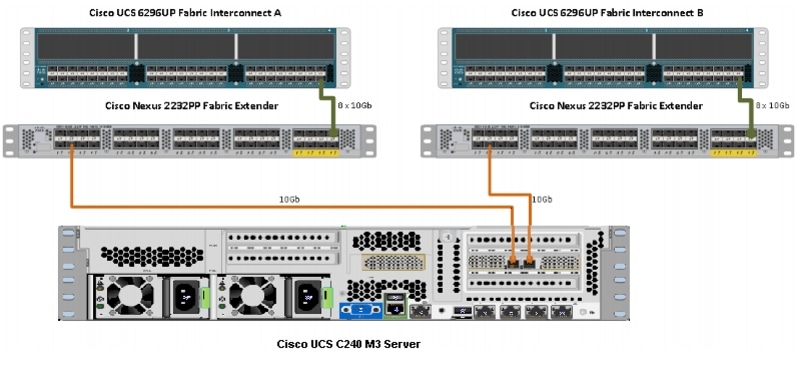
Figure 2 illustrates the port connectivity between the Cisco Nexus 2232PP FEX and the Cisco UCS C240M3 server.
Figure 2 Connectivity Diagram of Cisco Nexus 2232PP FEX and Cisco UCS C240M3 Servers
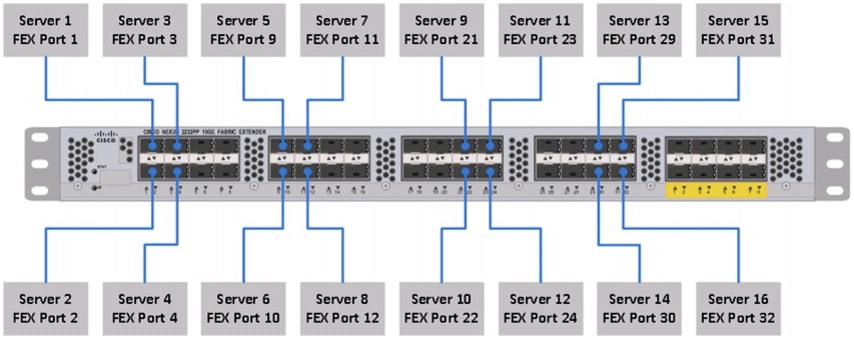
For more information on physical connectivity and single-wire management, see:
For more information on physical connectivity illustrations and cluster setup, see:
Figure 3 depicts a 64-node cluster, and each link represents 8 x 10 Gigabit link.
Figure 3 64 -Node Cluster Configuration
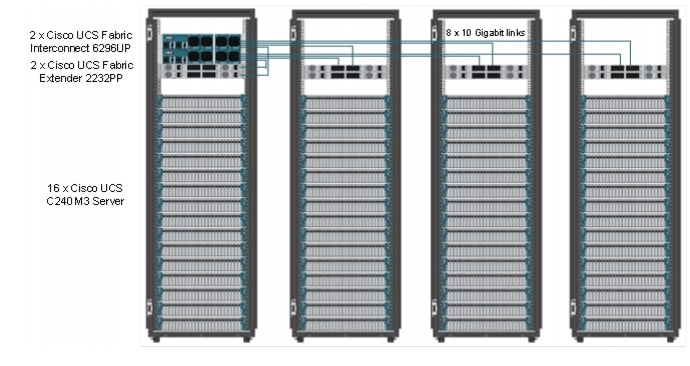
Software Distributions and Versions
Hortonworks Data Platform (HDP)
The Hortonworks Data Platform supported is HDP 1.3. For more information, see: http://www.hortonworks.com
RHEL
The Operating System supported is Red Hat Enterprise Linux Server 6.2. For more information on the Linux support, see:
Software Versions
Table 3 describes the software versions tested and validated in this document.

Note
To download the latest drivers, see: http://software.cisco.com/download/release.html?mdfid=284296254&flowid=31743&softwareid=283853158&release=1.5.1&relind=AVAILABLE&rellifecycle=&reltype=latest
Fabric Configuration
This section provides details for configuring a fully redundant, highly available Cisco UCS 6296 Fabric Interconnect.
1.
Initial setup of the Fabric Interconnect A and B.
2.
Connect to IP address of Fabric Interconnect A using web browser.
3.
Launch the Cisco UCS Manager.
4.
Edit the chassis discovery policy.
5.
Enable server and uplink ports.
6.
Create pools and polices for service profile template.
7.
Create Cisco Service Profile template and 64 service profiles.
8.
Start discover process.
9.
Associate to server.
Performing Initial Setup of Cisco UCS 6296 Fabric Interconnects
This section describes the steps to perform the initial setup of the Cisco UCS 6296 Fabric Interconnects A and B.
Configure Fabric Interconnect A
Follow these steps to configure the Fabric Interconnect A:
1.
Connect to the console port on the first Cisco UCS 6296 Fabric Interconnect.
2.
At the prompt to enter the configuration method, enter console to continue.
3.
If asked to either perform a new setup or restore from backup, enter setup to continue.
4.
Enter y to continue to set up a new Fabric Interconnect.
5.
Enter y to enforce strong passwords.
6.
Enter the password for the admin user.
7.
Enter the same password again to confirm the password for the admin user.
8.
When asked if this fabric interconnect is part of a cluster, enter y to continue.
9.
Enter A for the switch fabric.
10.
Enter the cluster name for the system name.
11.
Enter the Mgmt0 IPv4 address.
12.
Enter the Mgmt0 IPv4 netmask.
13.
Enter the IPv4 address of the default gateway.
14.
Enter the cluster IPv4 address.
15.
To configure DNS, enter y.
16.
Enter the DNS IPv4 address.
17.
Enter y to set up the default domain name.
18.
Enter the default domain name.
19.
Review the settings that were printed to the console, and enter yes to save the configuration.
20.
Wait for the login prompt to make sure the configuration has been saved.
Configure Fabric Interconnect B
Follow these steps to configure the Fabric Interconnect B:
1.
Connect to the console port on the second Cisco UCS 6296 Fabric Interconnect.
2.
When prompted to enter the configuration method, enter console to continue.
3.
The installer detects the presence of the partner fabric interconnect and adds this fabric interconnect to the cluster. Enter y to continue the installation.
4.
Enter the admin password that was configured for the first Fabric Interconnect.
5.
Enter the Mgmt0 IPv4 address.
6.
Enter yes to save the configuration.
7.
Wait for the login prompt to confirm that the configuration has been saved.
For more information on configuring Cisco UCS 6200 Series Fabric Interconnect, see:
Logging Into Cisco UCS Manager
Follow these steps to login to Cisco UCS Manager.
1.
Open a Web browser and navigate to the Cisco UCS 6296 Fabric Interconnect cluster address.
2.
Click the Launch link to download the Cisco UCS Manager software.
3.
If prompted, accept the security certificates.
4.
When prompted, enter the username as admin and the administrative password.
5.
Click Login.
Upgrading UCSM Software to Version 2.1(1e)
This document assumes the uses of Cisco UCS 2.1(1e). Make sure that the Cisco UCS C-Series version 2.1(1e) software bundle is installed on the Cisco UCS Fabric Interconnects.
To upgrade the Cisco UCS Manager software and Cisco UCS 6296 Fabric Interconnect software to version 2.1(1e), see: Upgrading Cisco UCS from Release 2.0 to Releases 2.1
Adding Block of IP Addresses for KVM Access
Follow these steps to create a block of KVM IP addresses for the server access in Cisco UCS environment.
1.
Click the LAN tab.
2.
Select Pools > IPPools > IP Pool ext-mgmt.
3.
Right-click Management IP Pool.
4.
Select Create Block of IP Addresses as sown in Figure 4
Figure 4 Adding Block of IP Addresses for KVM Access Part 1
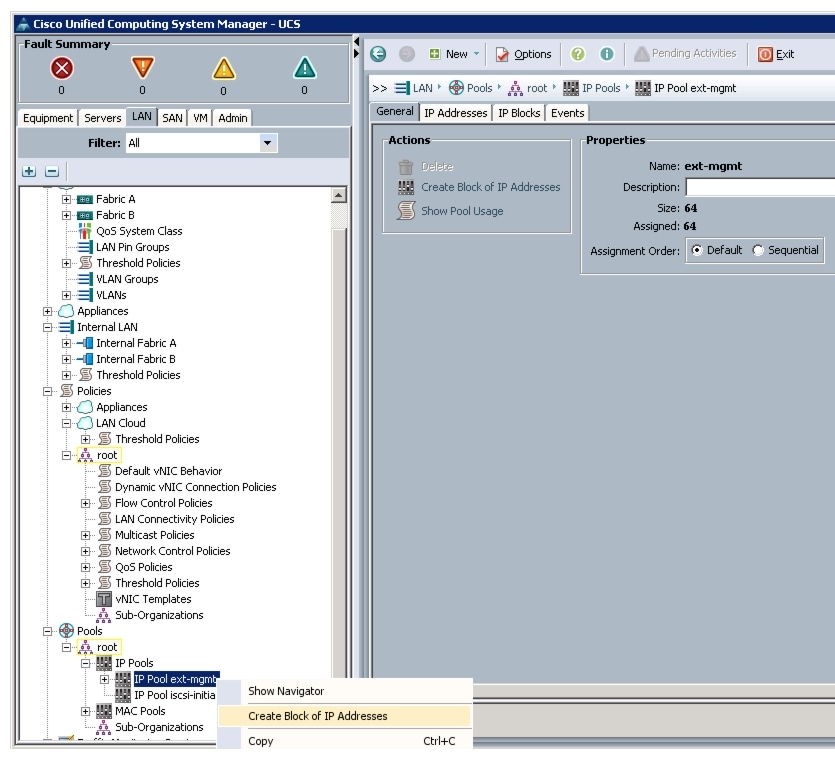
5.
Enter the starting IP address of the block and number of IPs needed, the subnet and the gateway information as shown in Figure 5.
Figure 5 Adding Block of IP Addresses for KVM Access Part 2

6.
Click OK to create the IP Address block as shown in Figure 6.
Figure 6 Adding Block of IP Addresses for KVM Access Part 3
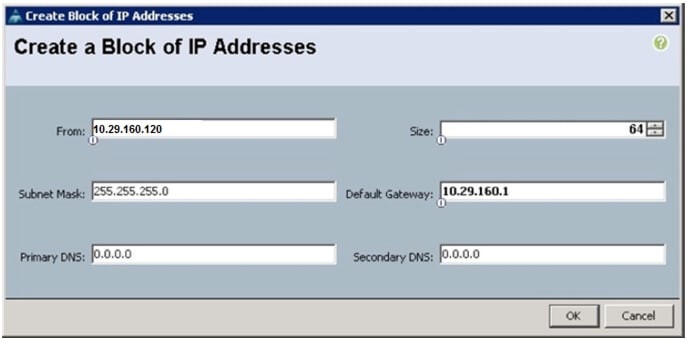
7.
Click OK.
Editing The Chassis Discovery Policy
This section provides details for modifying the chassis discovery policy. Setting the discovery policy ensures easy addition of the Cisco UCS B-Series chassis or fabric extenders for the Cisco UCS C-Series servers in future.
1.
Click the Equipment tab.
2.
In the right pane, click the Policies tab.
3.
Click the Global Policies tab.
4.
In the Chassis/FEX Discovery Policy area, select 8-link from the drop-down list for Action field as shown in Figure 7.
Figure 7 Changing The Chassis Discovery Policy
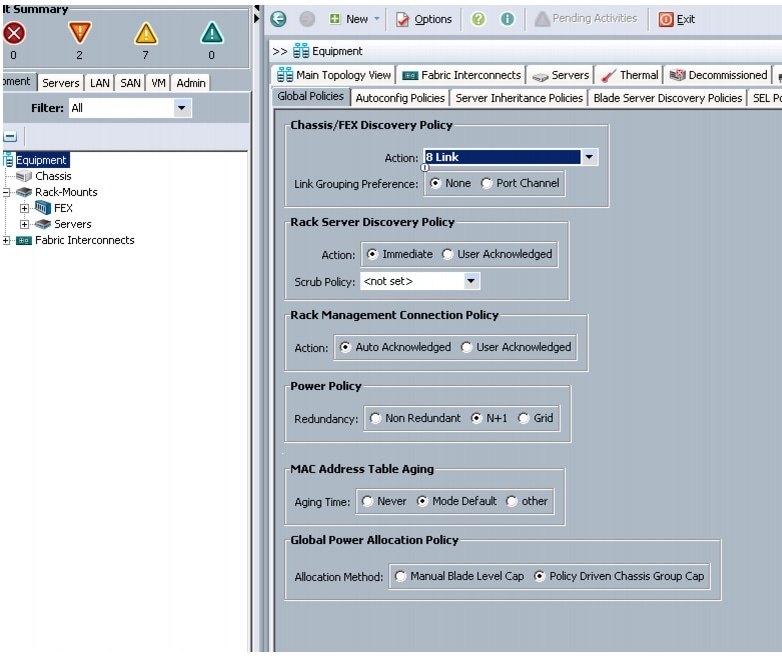
5.
Click Save Changes.
6.
Click OK.
Enabling The Server Ports and Uplink Ports
Follow these steps to enable the server and configure the uplink ports:
1.
Click the Equipment tab.
2.
Select Equipment > Fabric Interconnects > Fabric Interconnect A (primary) > Fixed Module.
3.
Expand the Unconfigured Ethernet Ports.
4.
Select all the ports that are connected to the Cisco 2232PP FEX (eight per FEX), right-click and select Reconfigure > Configure as a Server Port.
5.
Select port 1 that is connected to the uplink switch, right-click, then select Reconfigure > Configure as Uplink Port.
6.
Select Show Interface and select 10GB for Uplink Connection.
7.
Click Yes and then OK to continue.
8.
Select Equipment > Fabric Interconnects > Fabric Interconnect B (subordinate) > Fixed Module.
9.
Expand the Unconfigured Ethernet Ports section.
10.
Select all the ports that are connected to the Cisco 2232 Fabric Extenders (eight per Fex), right-click and select Reconfigure > Configure as Server Port.
11.
Click Yes and then OK to continue.
12.
Select port number 1, which is connected to the uplink switch, right-click and select Reconfigure > Configure as Uplink Port.
Figure 8 Enabling Server Ports
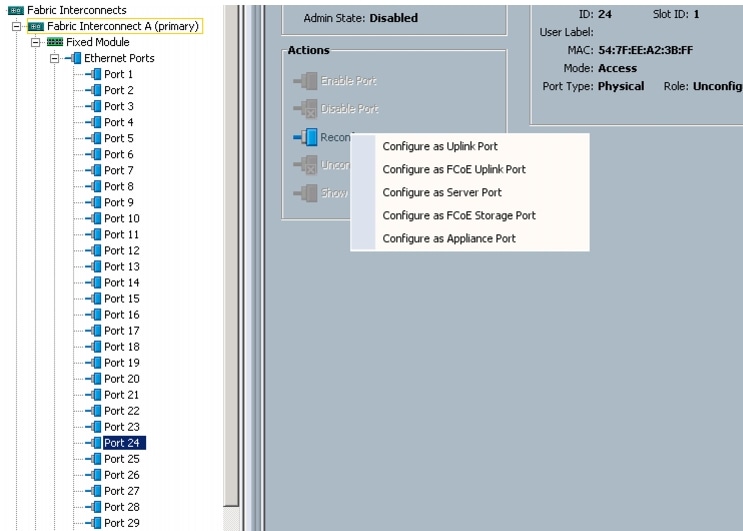
13.
Select Show Interface and select 10GB for Uplink Connection.
14.
Click Yes and then OK to continue.
Figure 9 shows all the configured uplink and Server ports.
Figure 9 Server and Uplink Ports Summary
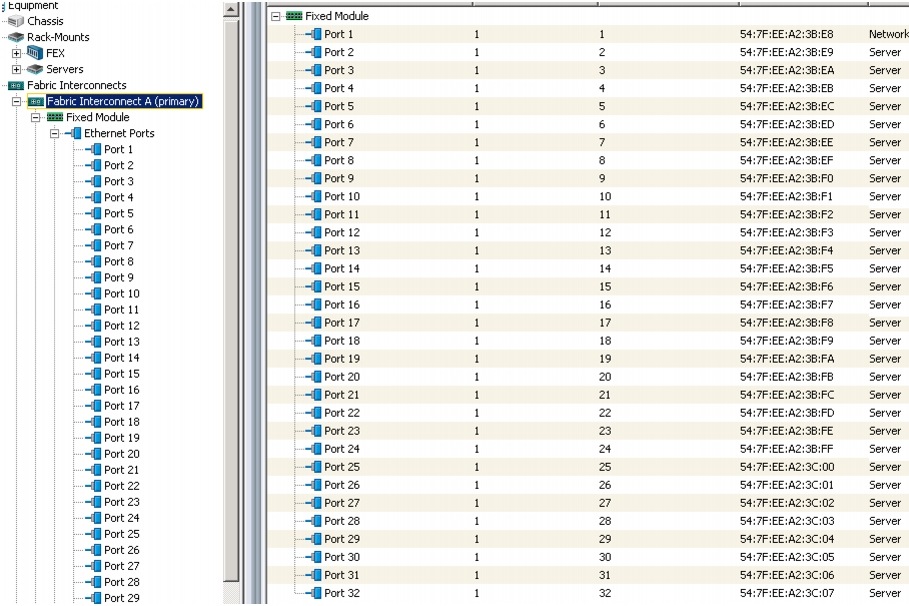
Creating Pools for Service Profile Templates
Creating an Organization
Organizations are used as a means to arrange and restrict access to various groups within the IT organization, and enable multi-tenancy of the compute resources. This document does not use organizations; however, the steps to create an organizations are given for future reference.
Follow these steps to configure an organization in the Cisco UCS Manager:
1.
Click New in the left corner of the UCS Manager GUI.
2.
Select Create Organization from the options.
3.
Enter a name for the organization.
4.
(Optional) Enter a description for the organization.
5.
Click OK.
Creating MAC Address Pools
Follow these steps to create MAC address pools:
1.
Click the LAN tab.
2.
Select Pools > root.
3.
Right-click MAC Pools under the root organization.
4.
Select Create MAC Pool to create the MAC address pool. Enter ucs as the name of the MAC pool.
5.
(Optional) Enter a description of the MAC pool.
6.
Click Next.
7.
Click Add.
8.
Specify a starting MAC address.
9.
Specify a size of the MAC address pool, which is sufficient to support the available server resources as shown in Figure 10.
10.
Click OK.
Figure 10 Specifying the First MAC Address and Size
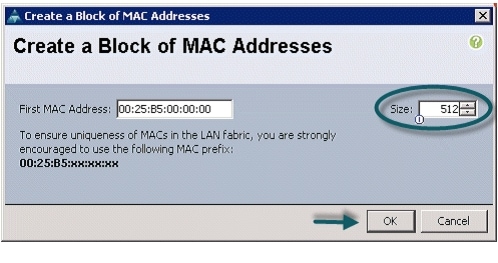
11.
Click Finish as shown in Figure 11.
Figure 11 Adding MAC Addresses
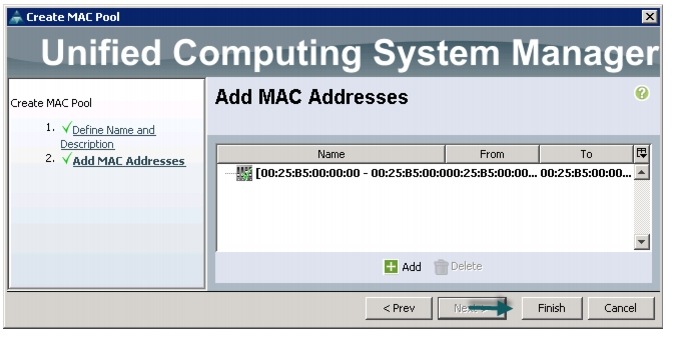
12.
Click OK to confirm the addition of the MAC addresses.
Configuring VLANs
Table 4 describes the VLANs that are configured in this design solution.
All of the VLANs created should be trunked to the upstream distribution switch connecting the fabric interconnects. In this deployment, vlan160_mgmt is configured for management access and user connectivity, vlan12_HDFS is configured for Hadoop interconnect traffic, and vlan11_DATA is configured for optional secondary interconnect and/or SAN/NAS access, heavy ETL, and so on.
Follow these steps to configure VLANs in Cisco UCS Manager:
1.
Click the LAN tab.
2.
Select LAN > VLANs.
3.
Right-click the VLANs under the root organization.
4.
Select Create VLANs to create the VLAN as shown in Figure 12.
Figure 12 Creating VLAN
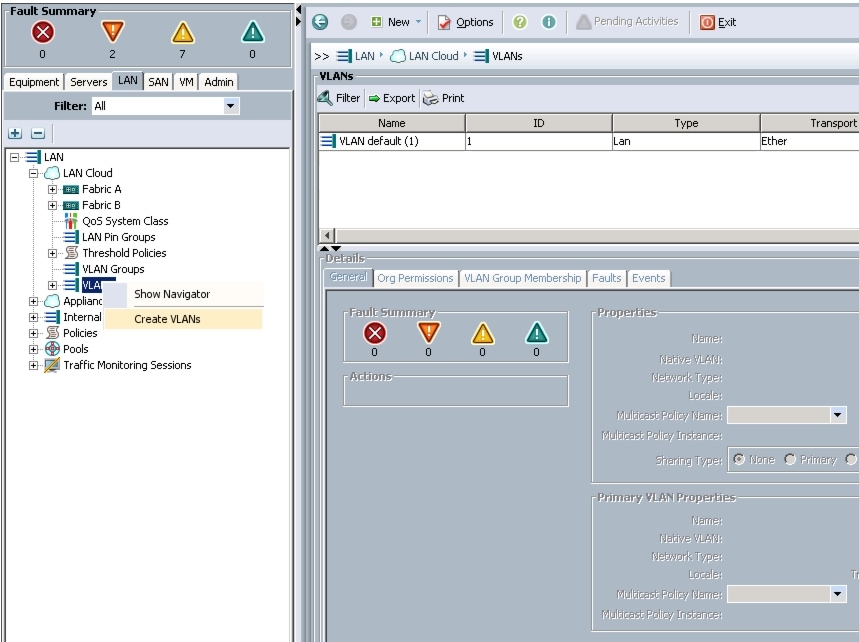
5.
Enter vlan160_mgmt in the VLAN Name/Prefix text box as shown in Figure 13.
6.
Click the Common/Global radio button.
7.
Enter 160 in the VLAN IDs text box.
8.
Click OK and then click Finish.
9.
Click OK.
Figure 13 Creating Management VLAN
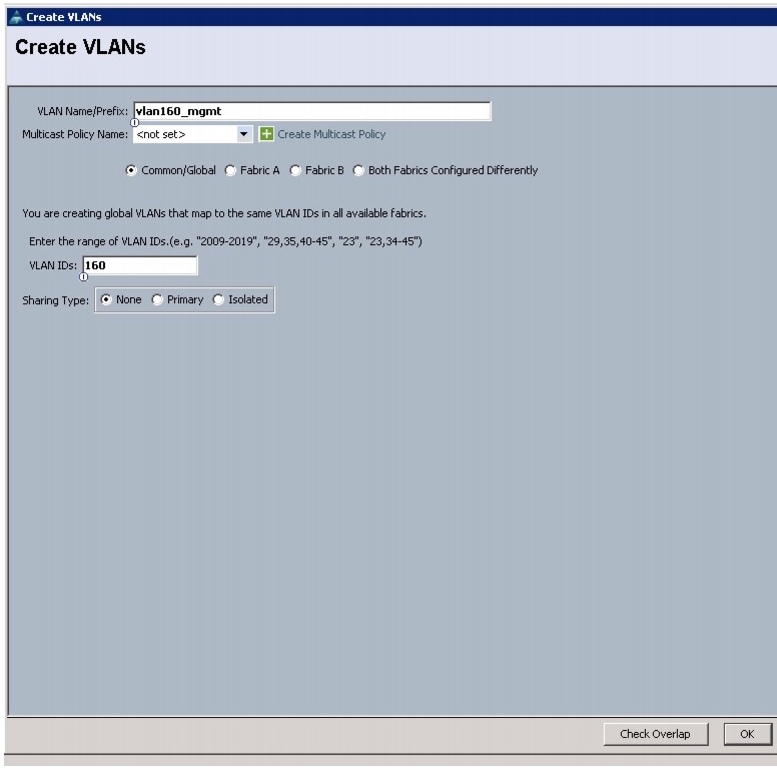
10.
Click the LAN tab.
11.
Select LAN > VLANs.
12.
Right-click the VLANs under the root organization.
13.
Select Create VLANs to create the VLAN as shown in Figure 14.
14.
Enter vlan11_DATA in the VLAN Name/Prefix text box.
15.
Click the Common/Global radio button.
16.
Enter 11 in the VLAN IDs text box.
17.
Click OK and then click Finish.
18.
Click OK.
Figure 14 Creating VLAN for Data
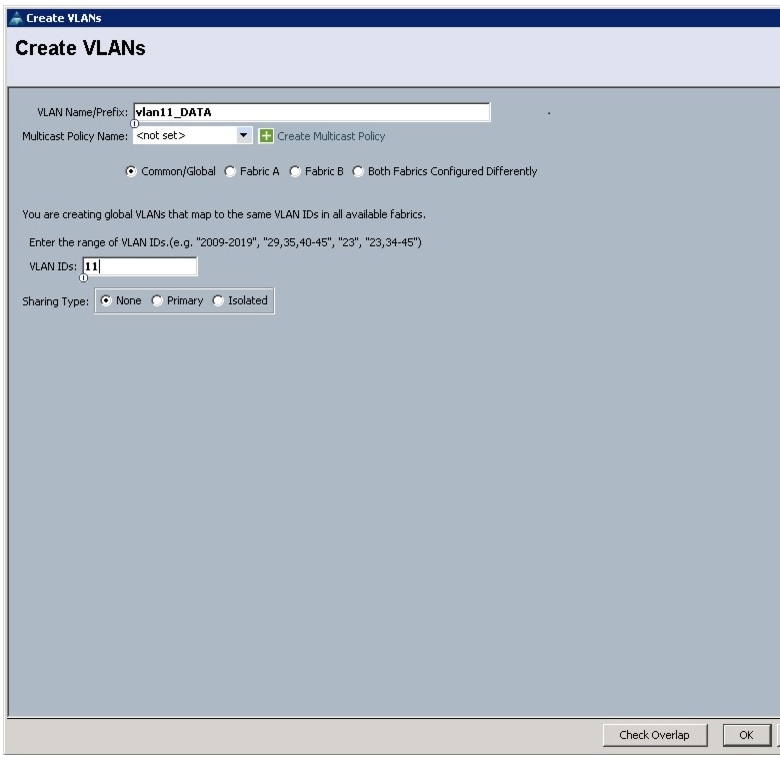
19.
Click the LAN tab.
20.
Select LAN > VLANs.
21.
Right-click the VLANs under the root organization.
22.
Select Create VLANs to create the VLAN.
23.
Enter vlan12_HDFS in the VLAN Name/Prefix text box as shown in Figure 15.
24.
Click the Common/Global radio button.
25.
Enter 12 in the VLAN IDs text box.
26.
Click OK and then click Finish.
Figure 15 Creating VLAN for Hadoop Data

Creating a Server Pool
A server pool contains a set of servers. These servers typically share the same characteristics such as their location in the chassis, server type, amount of memory, local storage, type of CPU, or local drive configuration. You can manually assign a server to a server pool, or use the server pool policies and server pool policy qualifications to automate the server assignment.
Follow these steps to configure the server pool within the Cisco UCS Manager:
1.
Click the Servers tab.
2.
Select Pools > root.
3.
Right-click the Server Pools.
4.
Select Create Server Pool.
5.
Enter the required name (ucs) for the server pool in the name text box as shown in Figure 16.
6.
(Optional) Enter a description for the organization.
Figure 16 Setting Name and Description of the Server Pool
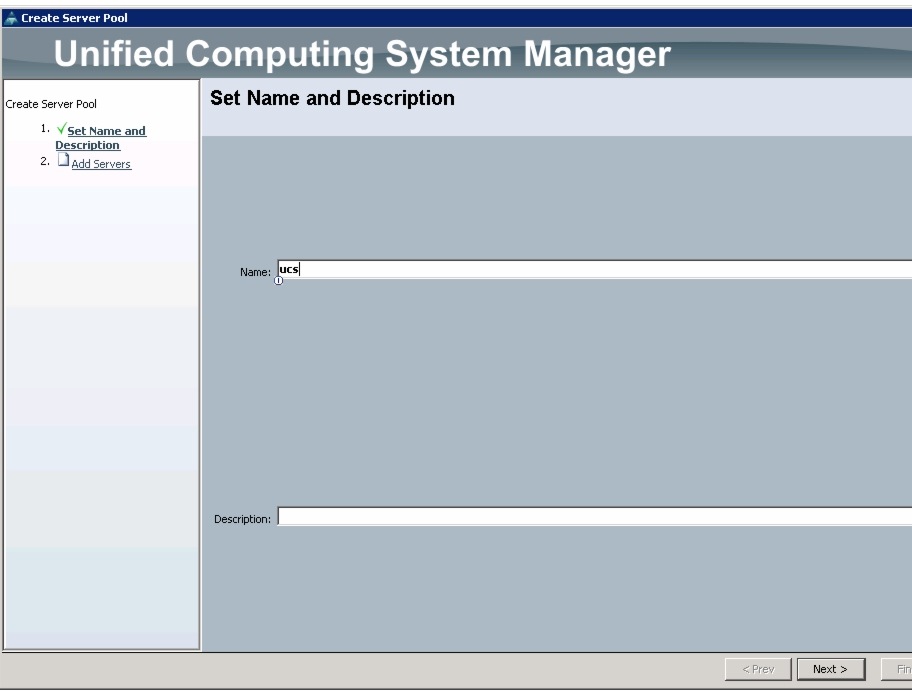
7.
Click Next to add the servers.
8.
Select all the Cisco UCS C240M3 servers to be added to the server pool that were previously created (ucs), then Click >> to add them to the pool as shown in Figure 17.
9.
Click OK, and then click Finish.
Figure 17 Adding Servers to the Server Pool
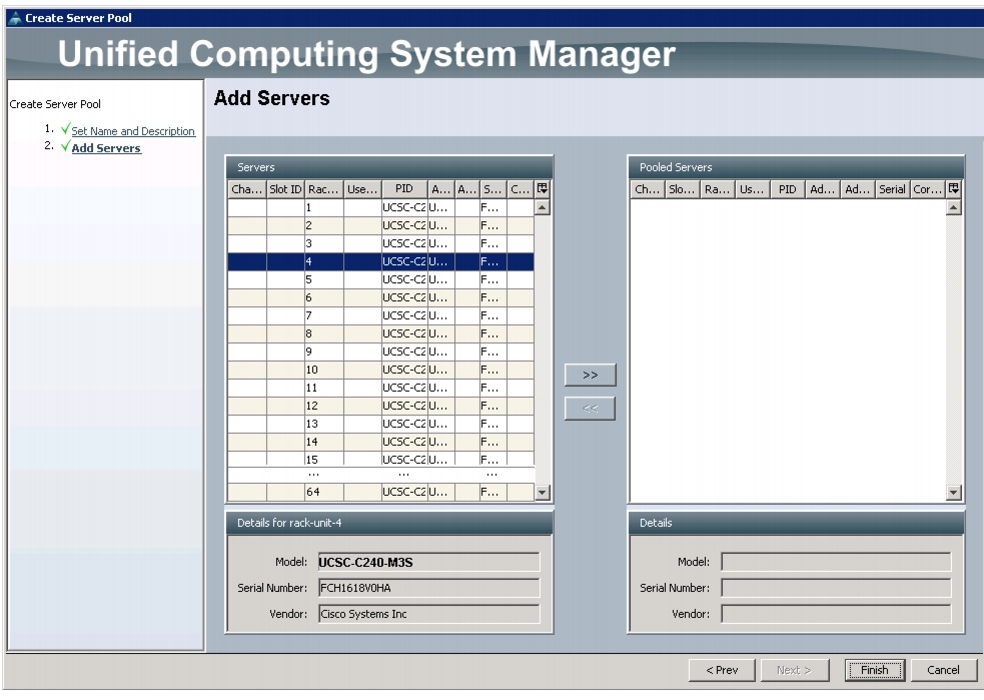
Creating Policies for Service Profile Templates
This section provides you the procedure to create the following policies for the service profile template:
•
Creating a Host Firmware Package Policy
•
Creating a Local Disk Configuration Policy
•
Creating a Server BIOS Policy
Creating a Host Firmware Package Policy
Firmware management policies allow the administrator to select the corresponding firmware packages for a given server configuration. The components that can be configured include adapters, BIOS, board controllers, FC adapters, HBA options, ROM and storage controller.
Follow these steps to create a host firmware management policy for a given server configuration using the Cisco UCS Manager:
1.
Click the Servers tab in the UCS Manager.
2.
Select Policies > root.
3.
Right-click Host Firmware Packages.
4.
Select Create Host Firmware Package.
5.
Enter the required host firmware package name (ucs) as shown in Figure 18.
6.
Click the Simple radio button to configure the host firmware package.
7.
Select the appropriate Rack Package value.
8.
Click OK to complete creating the management firmware package.
9.
Click OK.
Figure 18 Creating Host Firmware Package
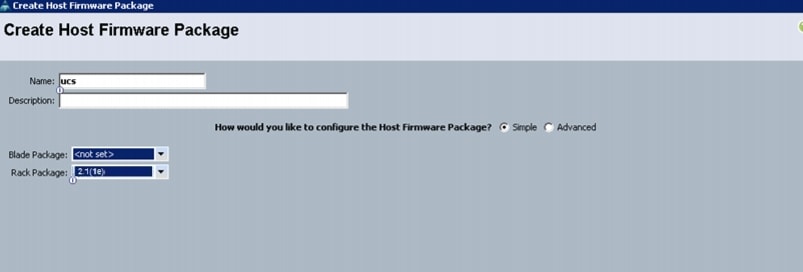
Creating QoS Policies
This section describes the procedure to create the Best Effort QoS Policy and Platinum QoS policy.
Creating the Best Effort Policy
Follow these steps to create the Best Effort Policy:
1.
Click the LAN tab.
2.
Select Policies > root.
3.
Right-click QoS Policies.
4.
Select Create QoS Policy as shown in Figure 19.
Figure 19 Creating QoS Policy
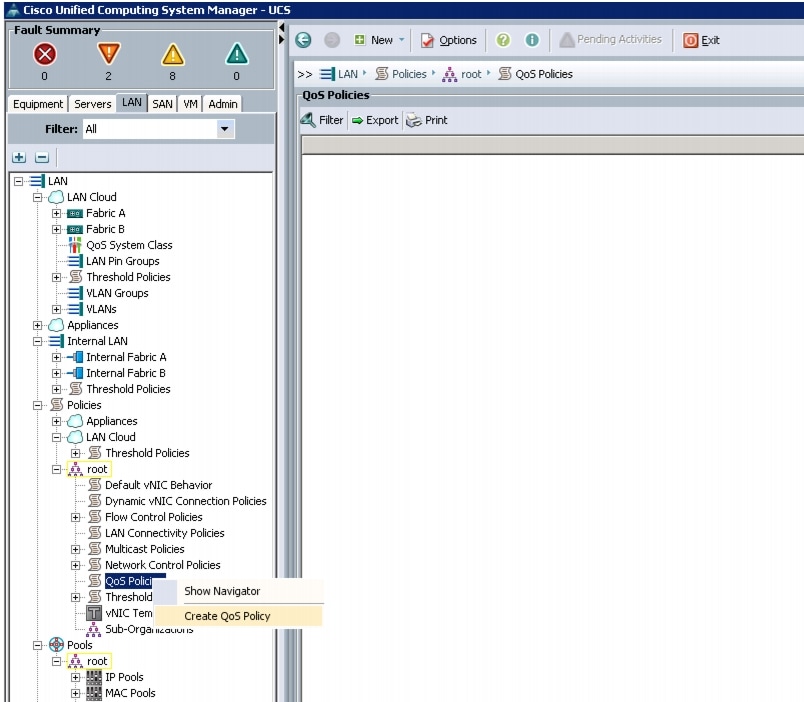
5.
Enter BestEffort as the name of the policy as shown in Figure 20.
6.
Select BestEffort from the drop down menu.
7.
Keep the Burst (Bytes) field as default (10240).
8.
Keep the Rate (Kbps) field as default (line-rate).
9.
Keep the Host Control radio button as default (none).
10.
Click OK to complete creating the Policy.
11.
Click OK.
Figure 20 Creating BestEffort QoS Policy
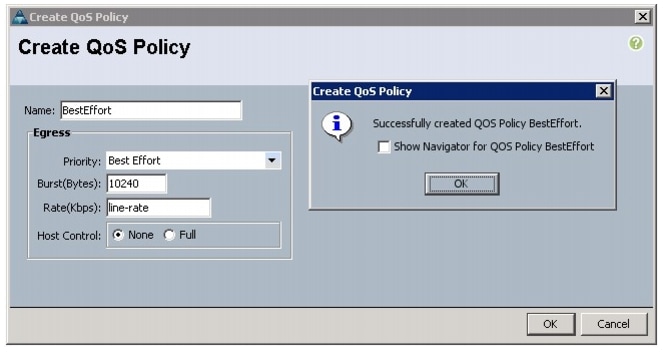
Creating a Platinum Policy
Follow these steps to create the Platinum QoS policy:
1.
Click the LAN tab.
2.
Select Policies > root.
3.
Right-click QoS Policies.
4.
Select Create QoS Policy.
5.
Enter Platinum as the name of the policy as shown in Figure 21.
6.
Select Platinum from the drop down menu.
7.
Keep the Burst (Bytes) field as default (10240).
8.
Keep the Rate (Kbps) field as default (line-rate).
9.
Keep the Host Control radio button as default (none).
10.
Click OK to complete creating the Policy.
11.
Click OK.
Figure 21 Creating Platinum QoS Policy
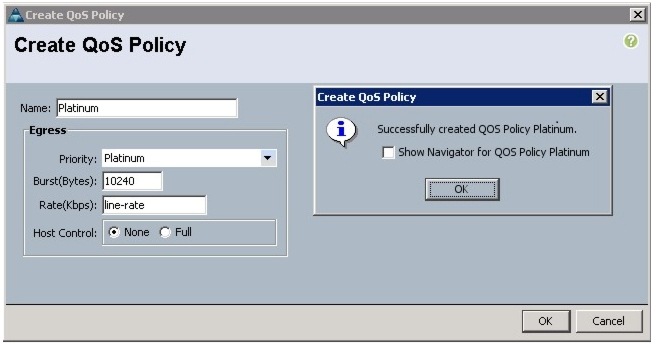
Setting Jumbo Frames
Follow these steps to set up Jumbo frames and enable the QoS:
1.
Click the LAN tab in the Cisco UCS Manager.
2.
Select LAN Cloud > QoS System Class.
3.
In the right pane, click the General tab.
4.
In the Platinum row, enter 9000 for MTU as shown in Figure 22.
5.
Check the Enabled check box.
6.
Click Save Changes.
7.
Click OK.
Figure 22 Setting Jumbo Frames
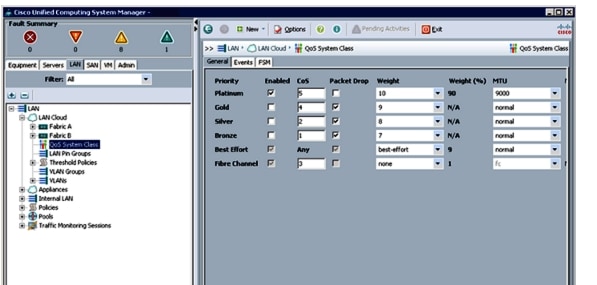
Creating a Local Disk Configuration Policy
Follow these steps to create a local disk configuration in the Cisco UCS Manager:
1.
Click the Servers tab.
2.
Select Policies > root.
3.
Right-click Local Disk Config Policies.
4.
Select Create Local Disk Configuration Policy.
5.
Enter ucs as the local disk configuration policy name as shown in Figure 23.
6.
Select Any Configuration from the drop-down list to set the Mode.
7.
Uncheck the Protect Configuration check box.
8.
Click OK to complete creating the Local Disk Configuration Policy.
9.
Click OK.
Figure 23 Configuring Local Disk Policy
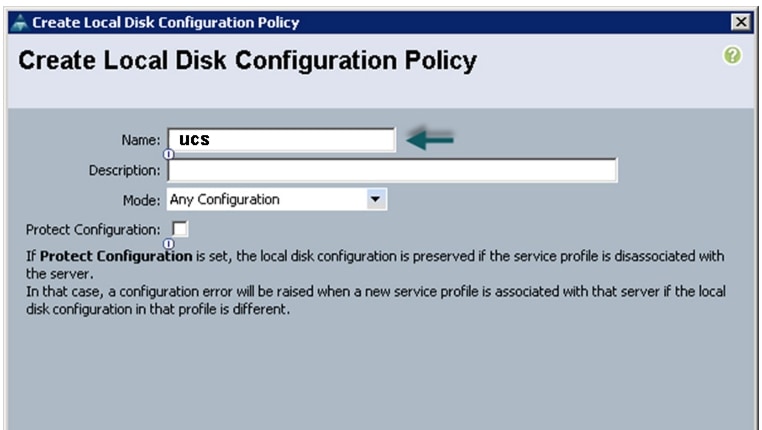
Creating a Server BIOS Policy
The BIOS policy feature in Cisco UCS automates the BIOS configuration process. The traditional mode of setting the BIOS is manual and is often error-prone. By creating a BIOS policy and assigning the policy to a server or group of servers, you can enable transparency within the BIOS settings configuration.

Note
BIOS settings can have a significant performance impact, depending on the workload and the applications. The BIOS settings listed in this section is for configurations optimized for best performance which can be adjusted based on the application, performance and energy efficiency requirements.
Follow these steps to create a server BIOS policy using the Cisco UCS Manager:
1.
Select the Servers tab.
2.
Select Policies > root.
3.
Right-click BIOS Policies.
4.
Select Create BIOS Policy.
5.
Enter the preferred BIOS policy name.
6.
Change the BIOS settings as shown in Figure 24.
Figure 24 Creating Server BIOS Policy
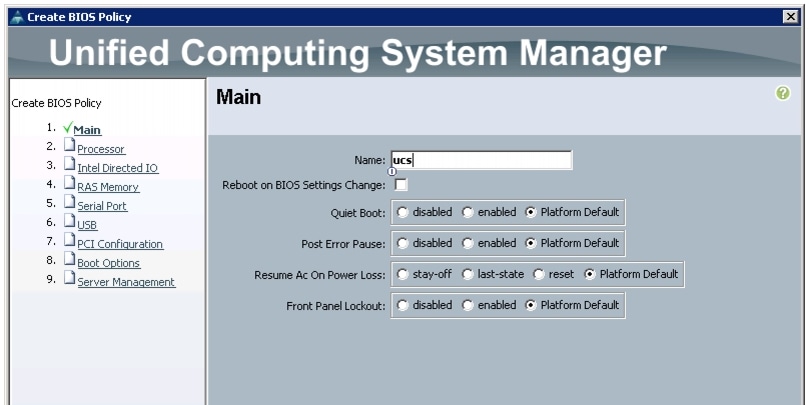
Figure 25 and Figure 26 show the Processor and Intel Directed IO properties settings in the BIOS Policy.
Figure 25 Creating Server BIOS Policy for Processor
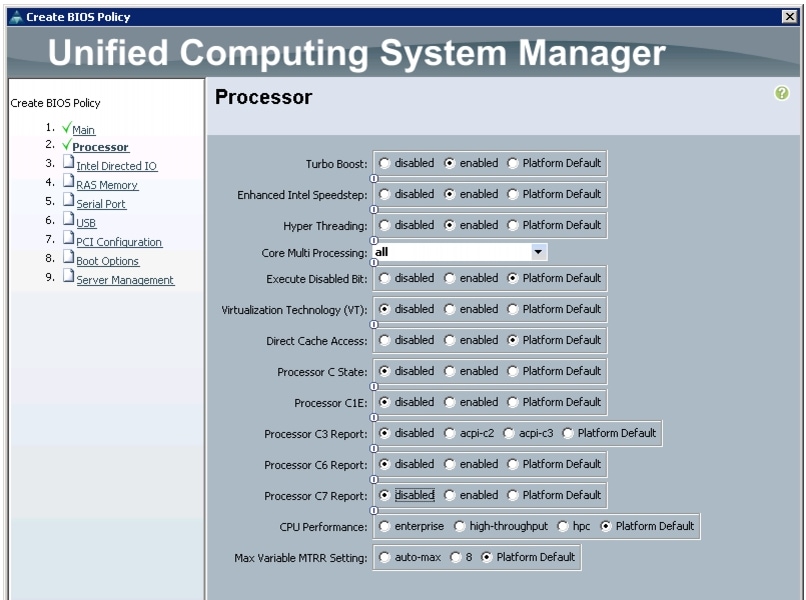
Figure 26 Creating Server BIOS Policy for Intel Directed IO
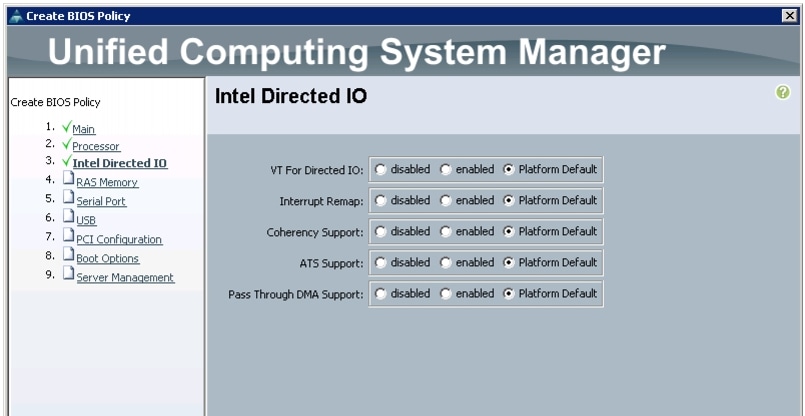
7.
Set the RAS Memory settings and click Next as shown in Figure 27.
Figure 27 Creating Server BIOS Policy for Memory
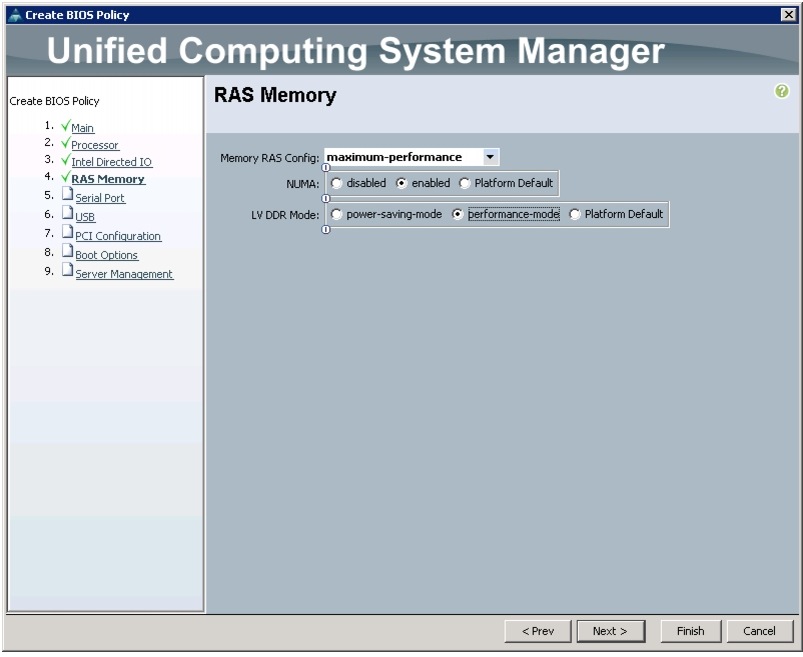
8.
Click Finish to complete creating the BIOS Policy.
9.
Click OK.
Creating a Boot Policy
Follow these steps to create a boot policy within Cisco UCS Manager:
1.
Select the Servers tab.
2.
Select Policies > root.
3.
Right-click the Boot Policies.
4.
Select Create Boot Policy as shown in Figure 28.
Figure 28 Creating Boot Policy Part 1
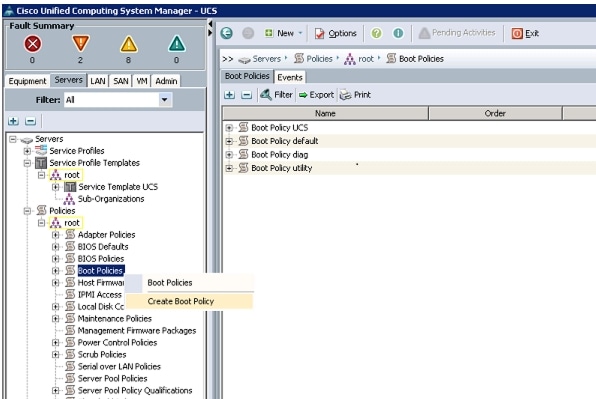
5.
Enter ucs as the boot policy name as shown in Figure 29.
6.
(Optional) Enter a description for the boot policy.
7.
Keep the Reboot on Boot Order Change check box as default (unchecked).
8.
Expand Local Devices and select Add CD-ROM.
9.
Expand Local Devices and select Add Local Disk.
10.
Expand vNICs and select Add LAN Boot and enter eth0.
11.
Click OK to add the Boot Policy.
12.
Click OK.
Figure 29 Creating Boot Policy Part 2
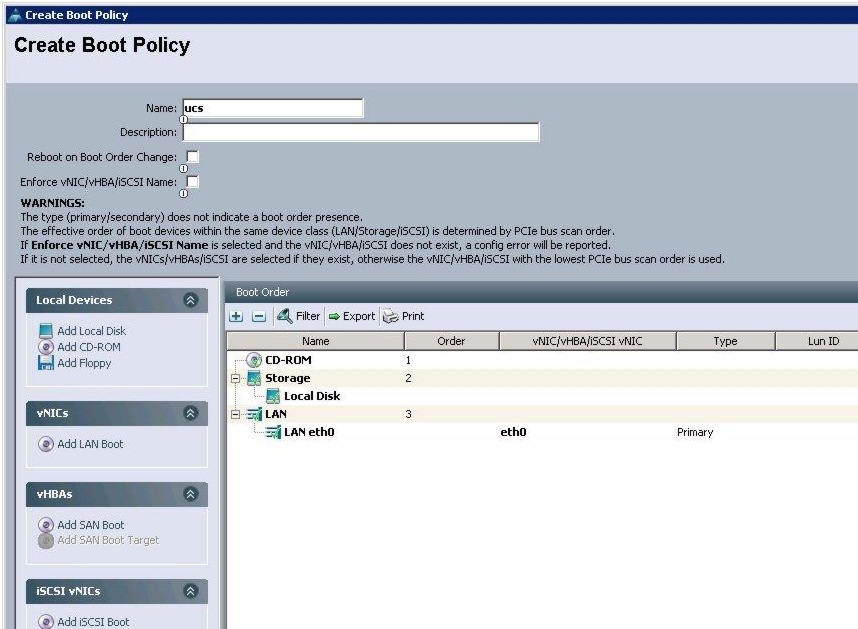
Creating a Service Profile Template
Follow these steps to create a service profile template in Cisco UCS Manager:
1.
Click the Servers tab.
2.
Select Policies > root.
3.
Right-click root.
4.
Select Create Service Profile Template as shown in Figure 30.
Figure 30 Creating Service Profile Template
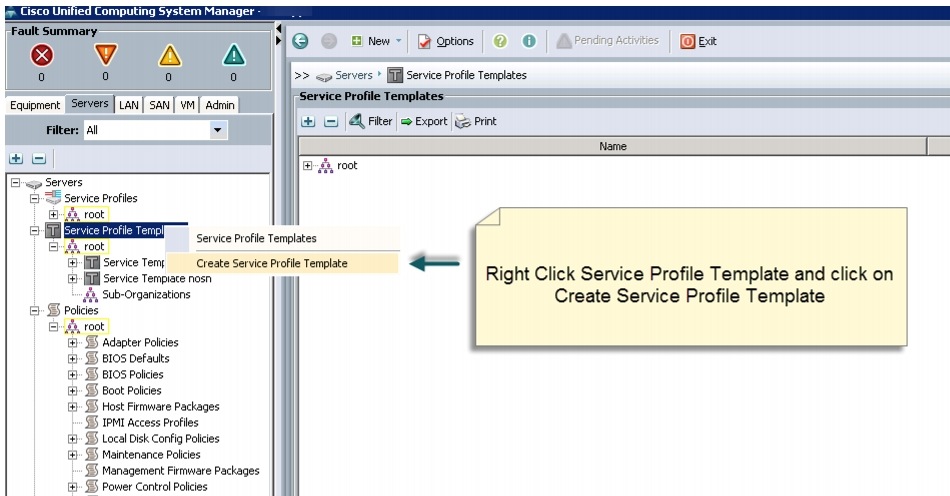
5.
The Create Service Profile Template window appears. Do the following (see Figure 31):
a.
In the Identify Service Profile Template window, enter the name of the service profile template as ucs.
b.
Click the Updating Template radio button.
c.
In the UUID section, select Hardware Default as the UUID pool.
6.
Click Next to continue.
Figure 31 Identify Service Profile Template
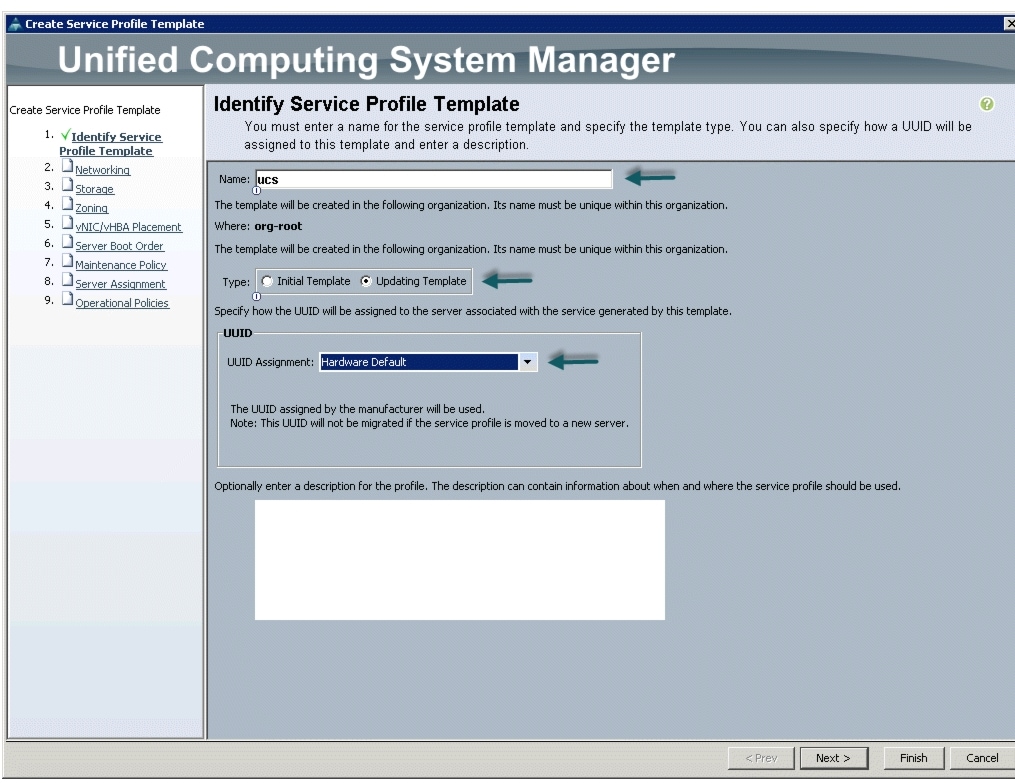
Configuring the Network Settings for the Template
In the Networking window, follow these steps to configure the network settings in the Cisco UCS Manager:
1.
Keep the Dynamic vNIC Connection Policy field at the default as shown in Figure 32.
2.
Click the Expert radio button to define How would you like to configure LAN connectivity?
3.
Click Add to add a vNIC to the template. The Modify vNIC window appears.
Figure 32 Configuring Network Settings for the Template
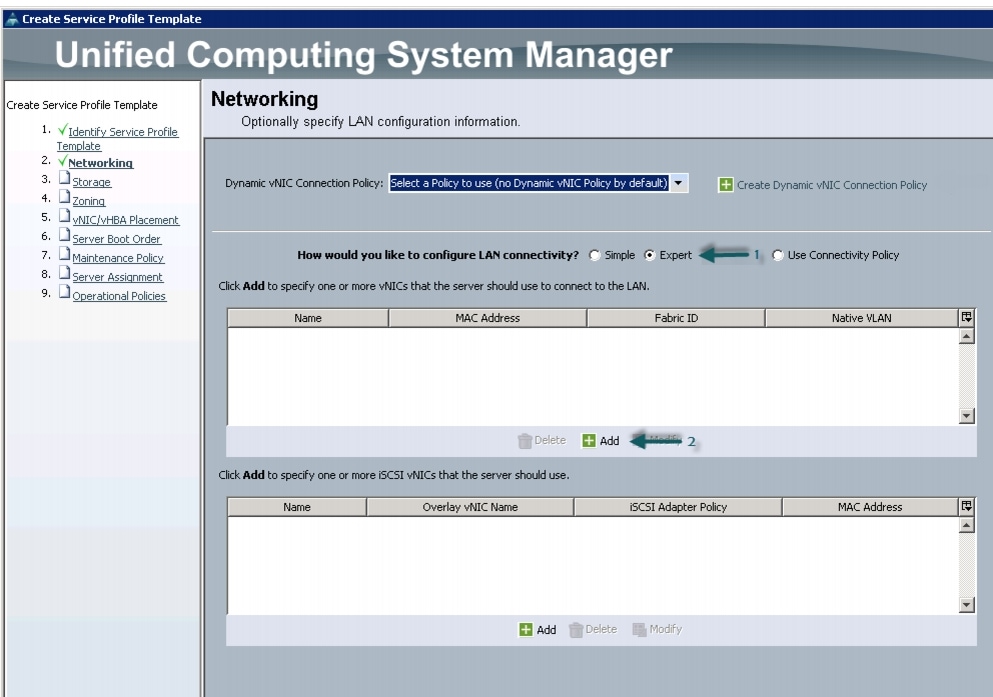
4.
In the Modify vNIC window, enter name for the vNIC as eth0 as shown in Figure 33.
5.
Select ucs in the MAC Address Assignment pool.
6.
Click the Fabric A radio button and check the Enable failover check box for the Fabric ID.
7.
Check the vlan160_mgmt check box for VLANs.
8.
Click the Native VLAN radio button.
9.
Select MTU size as 1500.
10.
Select adapter policy as Linux.
11.
Keep the Dynamic vNIC connection policy as <no set>.
12.
Select QoS Policy as BestEffort.
13.
Keep the Network Control Policy as default.
14.
Click OK.
Figure 33 Configuring vNIC eth0
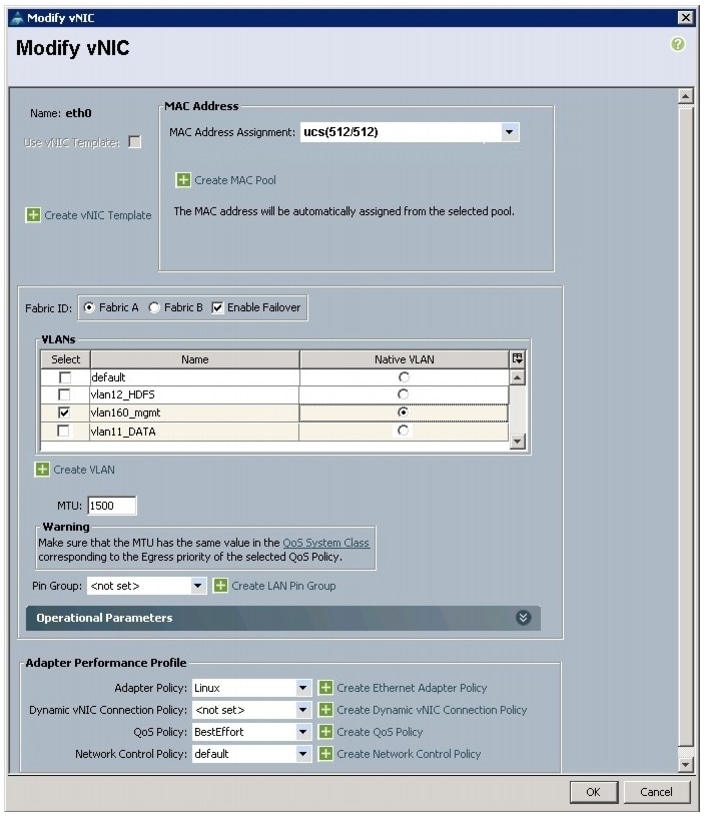
15.
The Modify vNIC window appears. Enter the name of the vNIC as eth1 as shown in Figure 34.
16.
Select ucs in the MAC Address Assignment pool.
17.
Click the Fabric B radio button and check the Enable failover check box for the Fabric ID.
18.
Check the vlan12_HDFS check box for VLANs and select the Native VLAN radio button.
19.
Select MTU size as 9000.
20.
Select adapter policy as Linux.
21.
Keep the Dynamic vNIC Connection Policy as <no set>.
22.
Select QoS Policy as Platinum.
23.
Keep the Network Control Policy as default.
24.
Click OK.
Figure 34 Configuring vNIC eth1
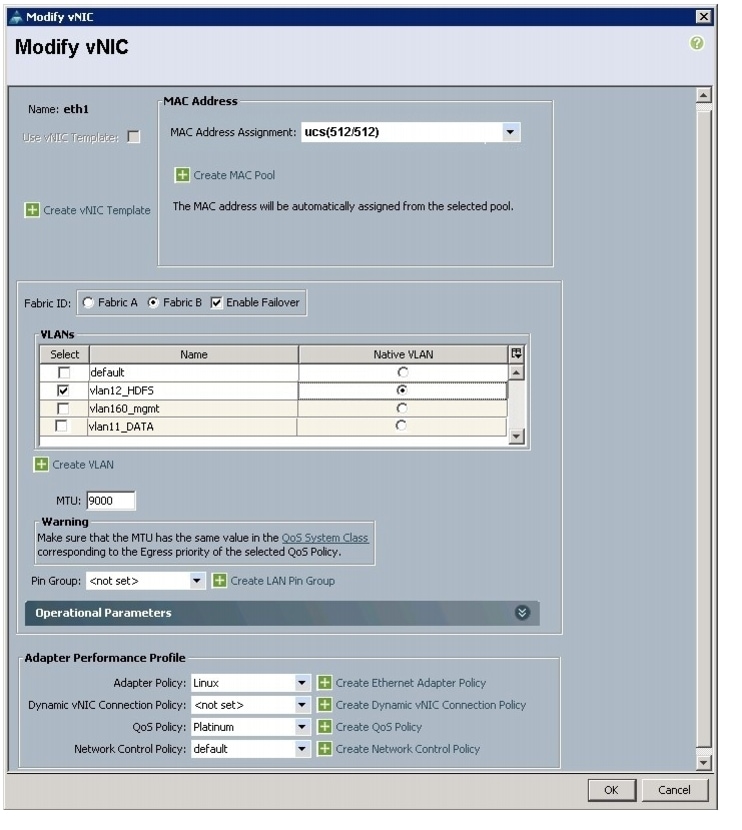
25.
The Create vNIC window appears. Enter the name of the vNIC as eth2 as shown in Figure 35.
26.
Select ucs in the MAC Address Assignment pool.
27.
Click the Fabric A radio button and check the Enable failover check box for the Fabric ID.
28.
Check the vlan11_DATA check box for VLANs and select the Native VLAN radio button.
29.
Select MTU size as 9000.
30.
Select adapter policy as Linux.
31.
Keep the Dynamic vNIC Connection Policy as <no set>.
32.
Select QoS Policy as Platinum.
33.
Keep the Network Control Policy as default.
34.
Click OK.
35.
Click Next in the Networking window to continue.
Figure 35 Configuring vNIC eth2
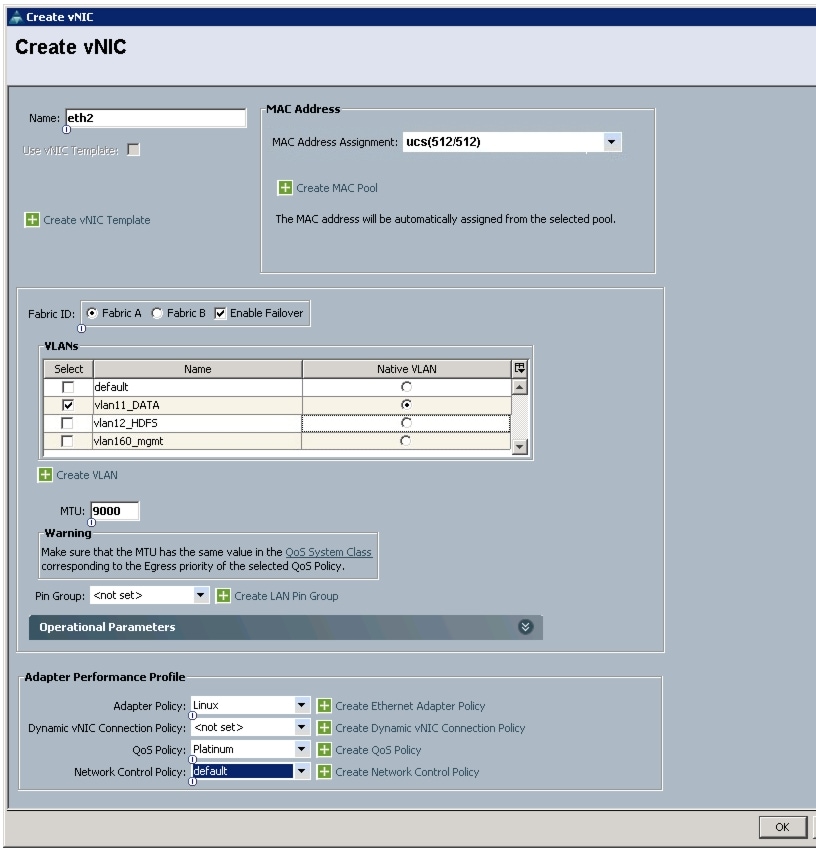
Configuring a Storage Policy for the Template
In the Storage window, follow these steps to configure a storage policy in Cisco UCS Manager:
1.
Select ucs for the local disk configuration policy as shown in Figure 36.
2.
Click the No vHBAs radio button to define How would you like to configure SAN connectivity?
3.
Click Next to continue.
Figure 36 Configuring Storage settings
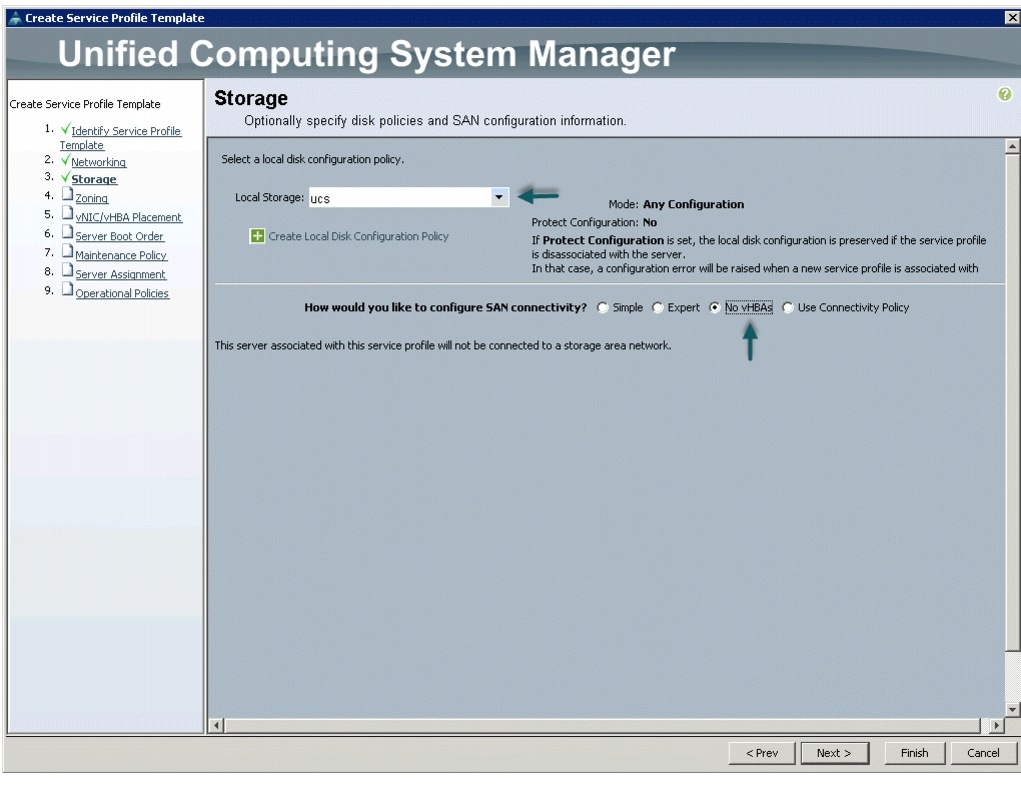
4.
Click Next in the Zoning window to continue.
Configuring a vNIC/vHBA Placement for the Template
In the vNIC/vHBA window, follow these steps to configure a vNIC/vHBA placement policy in Cisco UCS Manager:
1.
Select the Default Placement Policy option for the Select Placement field as shown in Figure 37.
2.
Select eth0, eth1 and eth2 assign the vNICs in the following order:
a.
eth0
b.
eth1
c.
eth2
Review to make sure that all vNICs are assigned in the appropriate order.
3.
Click Next to continue.
Figure 37 vNIC/vHBA Placement
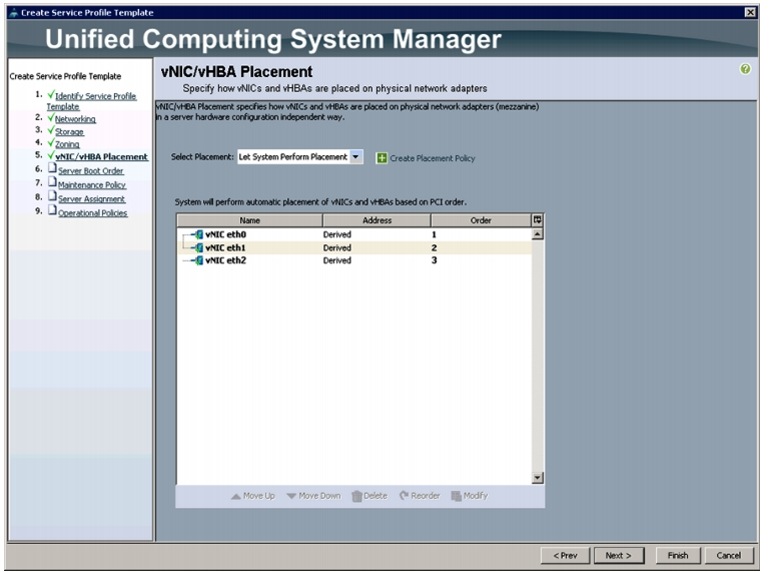
Configuring a Server Boot Order for the Template
In the Server Boot Order window, follow these steps to set the boot order for servers in Cisco UCS Manager:
1.
Select ucs in the Boot Policy name field as shown in Figure 38.
2.
Check the Enforce vNIC/vHBA/iSCSI Name check box.
Review to make sure that all the boot devices are created and identified.
3.
Verify that the boot devices are in the correct boot sequence.
4.
Click OK.
Figure 38 Creating Boot Policy
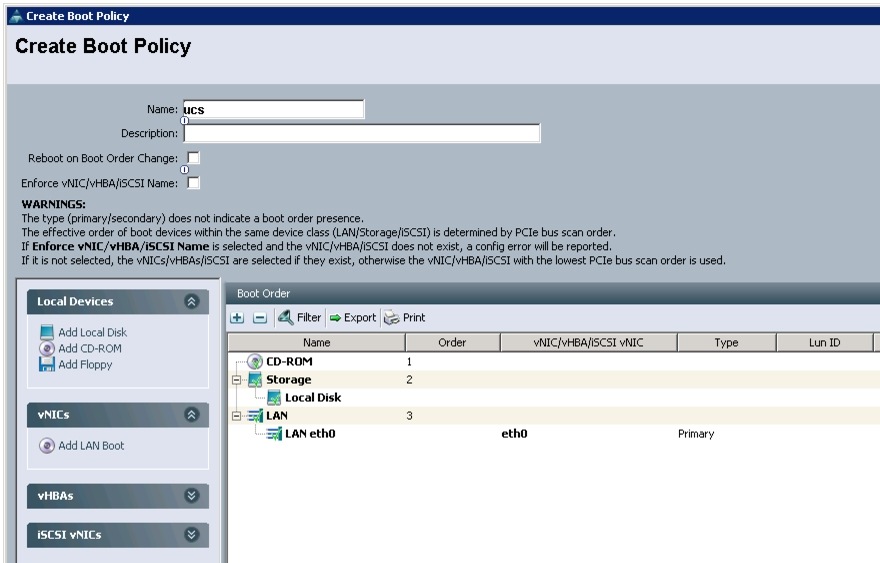
5.
Click Next to continue.
In the Maintenance Policy window, keep the default no policy as we have not created a policy. Click Next to continue to the next window.
Configuring Server Assignment for the Template
In the Server Assignment window, follow these steps to assign the servers to the pool in Cisco UCS Manager:
1.
Select ucs for the Pool Assignment field as shown in Figure 39.
2.
Keep the Server Pool Qualification field as default.
3.
Select ucs in Host Firmware Package.
Figure 39 Server Assignment
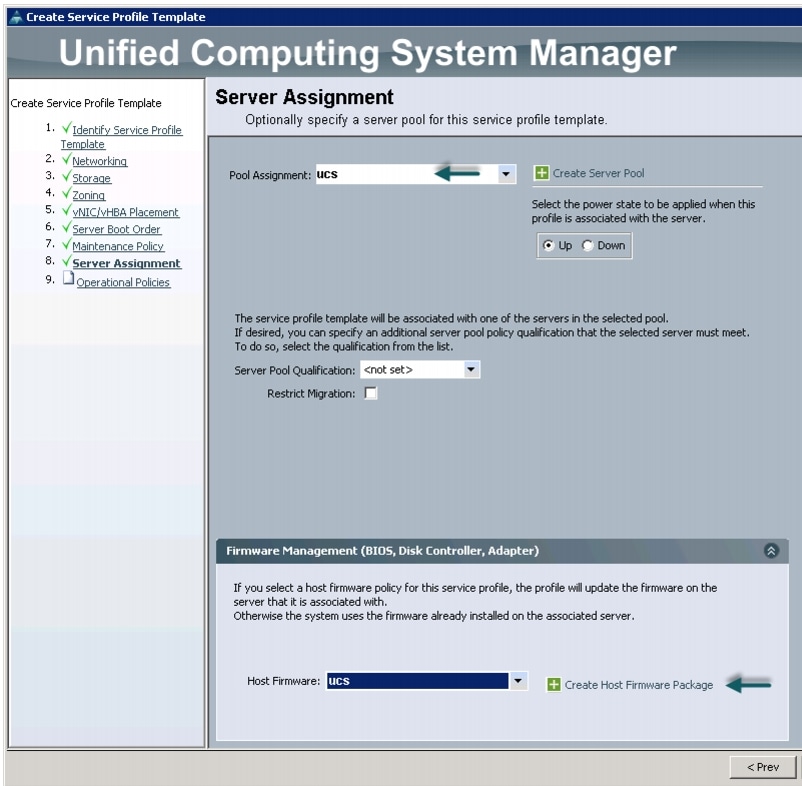
Configuring Operational Policies for the Template
In the Operational Policies window, follow these steps:
1.
Select ucs in the BIOS Policy field as shown in Figure 40.
2.
Click Finish to create the Service Profile template.
3.
Click OK.
Figure 40 Selecting BIOS Policy
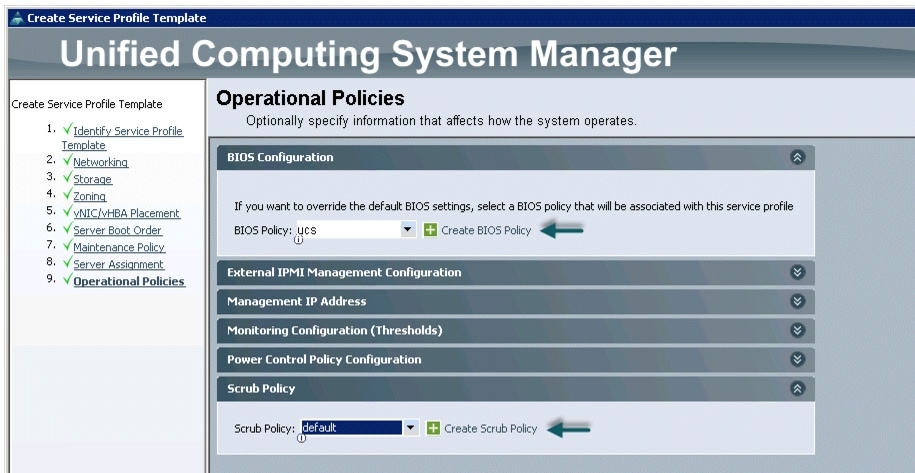
4.
Click the Servers tab.
a.
Select Service Profile Templates > root.
b.
Right-click root and select Create Service Profile Template as shown in Figure 41.
Figure 41 Creating Service Profiles from Template
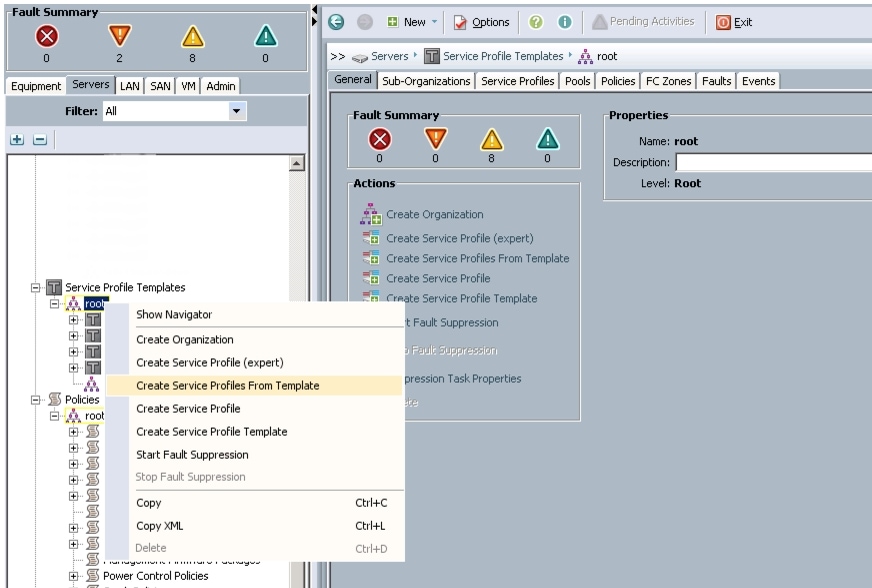
c.
The Create Service Profile from Template window appears. Enter the name and number of nodes in the Name and Number fields as shown in Figure 42.
Figure 42 Selecting Name and Total Number of Service Profiles
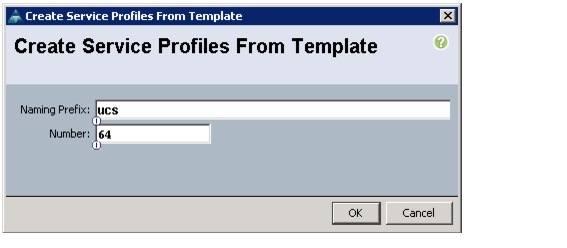
The Cisco UCS Manager discovers the servers and automatically associate these servers with service profiles. Figure 43 illustrates the service profiles associated with all the 64-nodes.
Figure 43 Cisco UCS Manager showing 64 Nodes
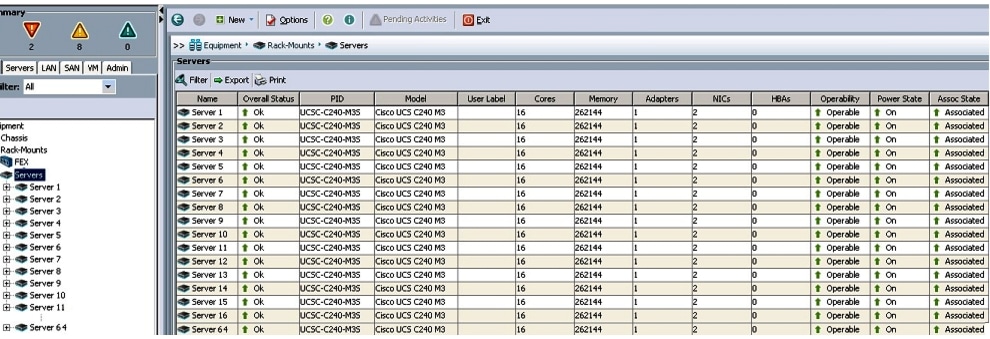
Configuring Disk Drives for Operating System on NameNode
Namenode and Secondary Namenode have a different RAID configuration compared to Datanodes. This section details the configuration of disk drives for OS on these nodes (rhel1 and rhel2). The disk drives are configured as RAID1, read ahead cache and write cache are enabled when the battery is available. The first two disk drives are used for the Operating System and the remaining 22 disk drives are used for the HDFS as described in the following sections.
There are several ways to configure RAID such as using the LSI WebBIOS Configuration Utility embedded in the MegaRAID BIOS, booting DOS and running MegaCLI commands, using Linux-based MegaCLI commands, or using third party tools that have MegaCLI integrated. For this deployment, the first disk drive is configured using the LSI WebBIOS Configuration Utility and the remaining drives are configured using Linux-based MegaCLI commands after the completion of the Operating System installation.
Figure 44 RAID 1 Configured Using LSI WebBIOS Utility and MegaCLI
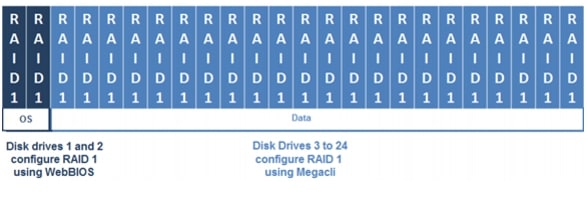
Follow these steps to create RAID1 on the first disk drive to install the Operating System:
1.
Boot the server, and do the following:
a.
Press <Ctrl><H> to launch the WebBIOS.
b.
Press Ctrl+H immediately. The Adapter Selection window appears.
2.
Click Start to continue as shown in Figure 45.
3.
Click Configuration Wizard.
Figure 45 Adapter Selection for RAID Configuration

4.
In the Configuration Wizard window, click the Clear Configuration radio button as shown in Figure 46.
5.
Click Next to clear the existing configuration.
Figure 46 Clearing Current configuration on the controller
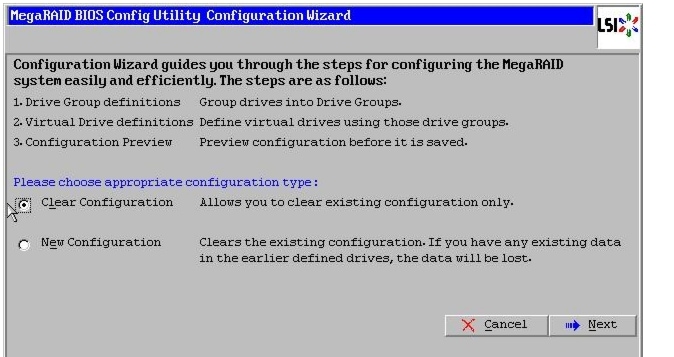
6.
Click Yes.
7.
In the Physical View, ensure that all the drives are Unconfigured Good.
8.
In the Configuration Wizard window, click the New Configuration radio button as shown in Figure 47.
9.
Click Next.
Figure 47 Choosing to create a New Configuration
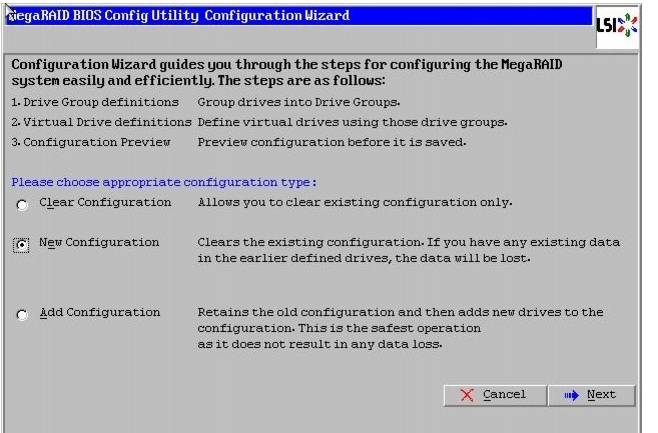
10.
Click the Manual Configuration radio button. This enables complete control over all attributes of the new storage configuration, such as, configuration of the drive groups, virtual drives and setting the parameters as shown in Figure 48.
Figure 48 Choosing Manual Configuration Method
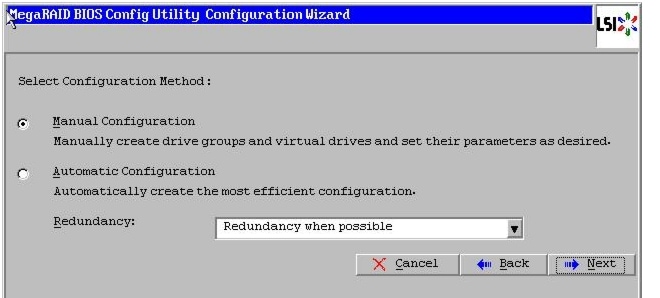
11.
Click Next. The Drive Group Definition window appears.
12.
In the Drive Group Definition window, choose the first two drives to create drive groups as shown in Figure 49.
13.
Click Add to Array to move the drives to a proposed drive group configuration in the Drive Groups pane.
14.
Click Accept DG and click Next.
Figure 49 Selecting first drive and Adding to Drive Group
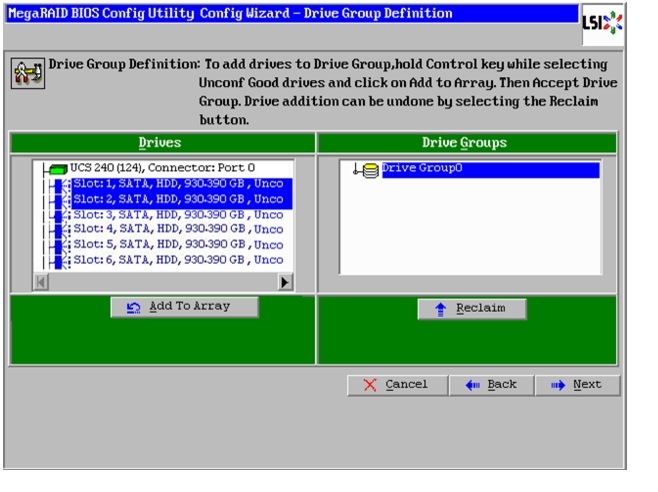
15.
In the Span Definitions window, click Add to SPAN and click Next as shown in Figure 50.
Figure 50 Span Definition Window
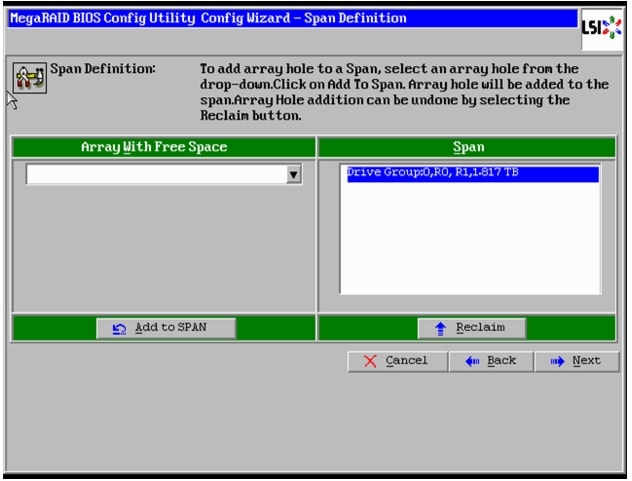
16.
In the Virtual Drive definitions window, do the following (see Figure 51):
a.
Click on Update Size.
b.
Change Strip Size to 1MB. A larger strip size ensures higher read performance.
c.
From the Read Policy drop-down list, choose Always Read Ahead.
d.
From the Write Policy drop-down list, choose Write Back with BBU.
e.
Make sure RAID Level is set to RAID1.
f.
Click Accept to accept the changes to the virtual drive definitions.
g.
Click Next.

Note
Clicking on Update Size can change some of the settings in the window. Make sure all settings are correct before submitting the changes.
Figure 51 Defining Virtual Drive
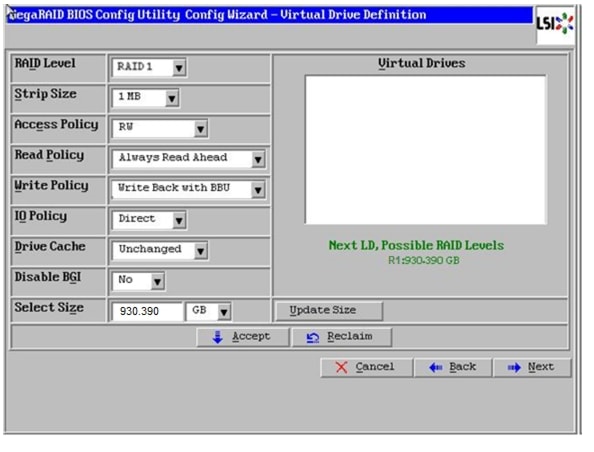
17.
Click Yes to save the configuration.
18.
In the Managing SSD Caching window, click Cancel as shown in Figure 52.
Figure 52 SSD Caching Window
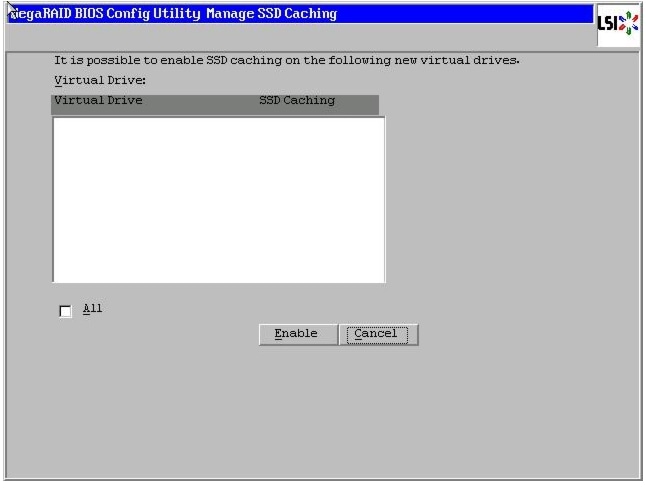
19.
Click Yes in the confirmation page.
20.
Set VD0 as the Boot Drive and click Go as shown in Figure 53.
Figure 53 Setting Virtual Drive as Boot Drive
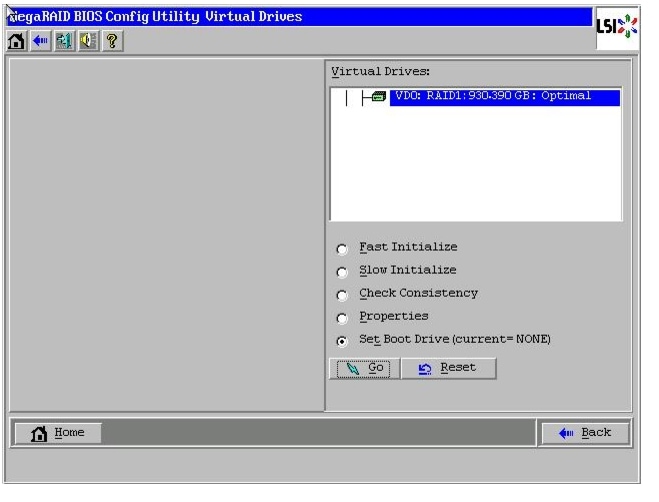
21.
Click Home.
22.
Review the configuration and click Exit.
Configuration of disks 2 to 24 are done using Linux based MegaCLI commands described in "Configuring Data Drives on NameNode" section.
Configuring Disk Drives for Operating System on DataNodes
Nodes 3 through 64 are configured as DataNodes. This section details the configuration of disk drives for OS on the data nodes. The focus of this CVD is on the High Performance Configuration, featuring 24 1TB SFF disk drives. The disk drives are configured as individual RAID0 volumes with 1MB strip size. Read ahead cache and write cache are enabled when the battery is available. The first disk drive is used for the Operating System and the remaining 23 disk drives are used for the HDFS as described in the following sections.

Note
In case of the High Capacity Configuration featuring 12 3TB LFF disk drives, the disk drives are configured as individual RAID0 volumes with 1MB strip size. Read ahead cache and write cache are enabled when the battery is available. Two partitions of 1TB and 2TB are created on the first disk drive, the 1TB partition is used for the Operating System and the 2TB partition is used for the HDFS along with disk drives 2 through 12.
There are several ways to configure RAID. RAID can be configured using LSI WebBIOS Configuration Utility embedded in the MegaRAID BIOS, booting DOS and running MegaCLI commands, Linux based MegaCLI commands, or by third party tools having MegaCLI. For this deployment, the first disk drive is configured using LSI WebBIOS Configuration Utility and the rest of them are configured using a Linux based MegaCLI commands after the completion of OS installation.
Follow these steps to create RAID0 on the first disk drive to install the Operating System:
1.
Boot the server, and do the following:
a.
Press <Ctrl><H> to launch the WebBIOS.
b.
Press Ctrl+H immediately. The Adapter Selection window appears.
2.
Click Start to continue as shown in Figure 45.
3.
Click Configuration Wizard.
Figure 54 Adapter Selection for RAID Configuration

4.
In the Configuration Wizard window, click the Clear Configuration radio button as shown in Figure 46.
5.
Click Next to clear the existing configuration.
Figure 55 Clearing Current configuration on the controller
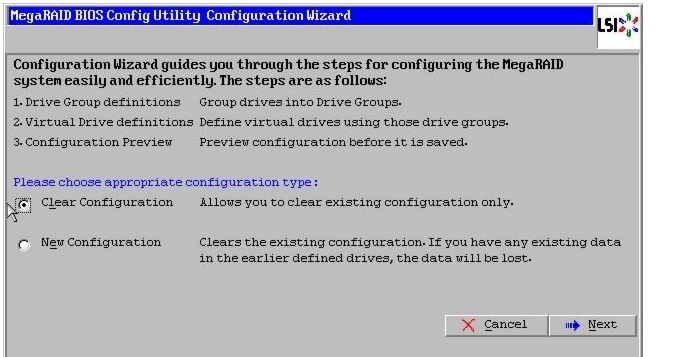
6.
Click Yes.
7.
In the Physical View, ensure that all the drives are Unconfigured Good.
8.
In the Configuration Wizard window, click the New Configuration radio button as shown in Figure 47.
9.
Click Next.
Figure 56 Choosing to create a New Configuration
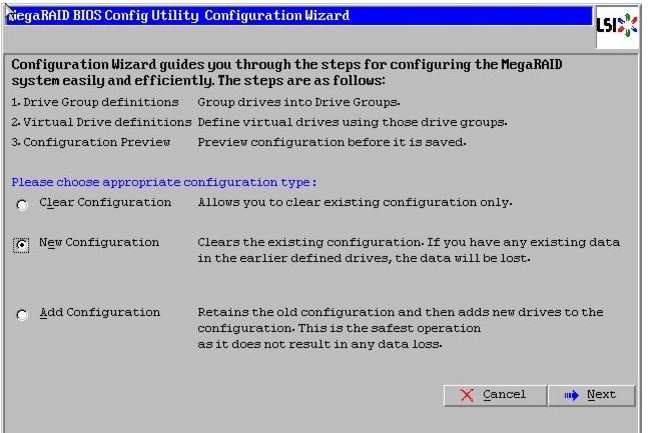
10.
Click the Manual Configuration radio button. This enables complete control over all attributes of the new storage configuration, such as, configuration of the drive groups, virtual drives and setting the parameters as shown in Figure 48.
Figure 57 Choosing Manual Configuration Method
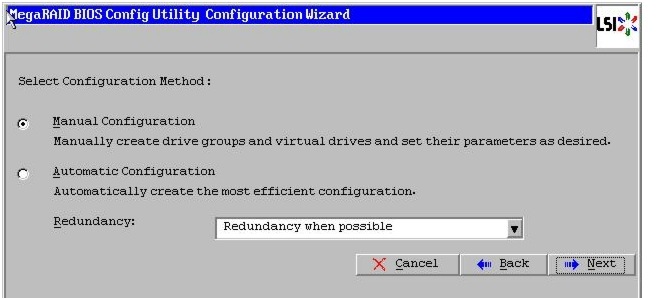
11.
Click Next. The Drive Group Definition window appears.
12.
In the Drive Group Definition window, choose the first drive to create drive groups as shown in Figure 49.
13.
Click Add to Array to move the drives to a proposed drive group configuration in the Drive Groups pane.
14.
Click Accept DG and click Next.
Figure 58 Selecting first drive and Adding to Drive Group
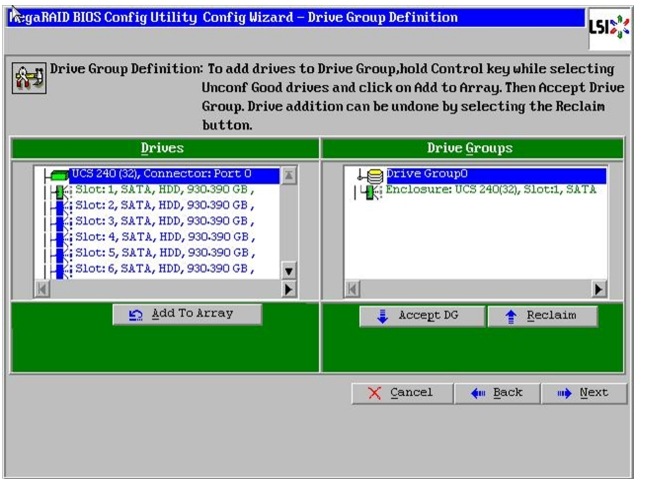
15.
In the Span Definitions window, click Add to SPAN and click Next as shown in Figure 50.
Figure 59 Span Definition Window
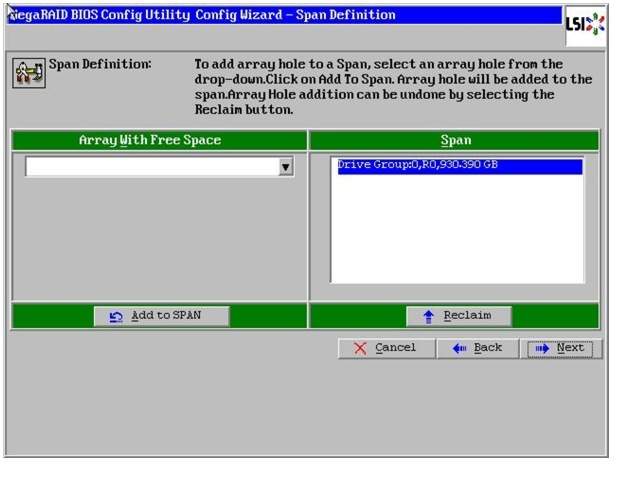
16.
In the Virtual Drive definitions window, do the following (see Figure 51):
a.
Click on Update Size.
b.
Change Strip Size to 1MB. A larger strip size ensures higher read performance.
c.
From the Read Policy drop-down list, choose Always Read Ahead.
d.
From the Write Policy drop-down list, choose Write Back with BBU.
e.
Make sure RAID Level is set to RAID0.
f.
Click Accept to accept the changes to the virtual drive definitions.
g.
Click Next.

Note
Clicking on Update Size can change some of the settings in the window. Make sure all settings are correct before submitting the changes.
Figure 60 Defining Virtual Drive
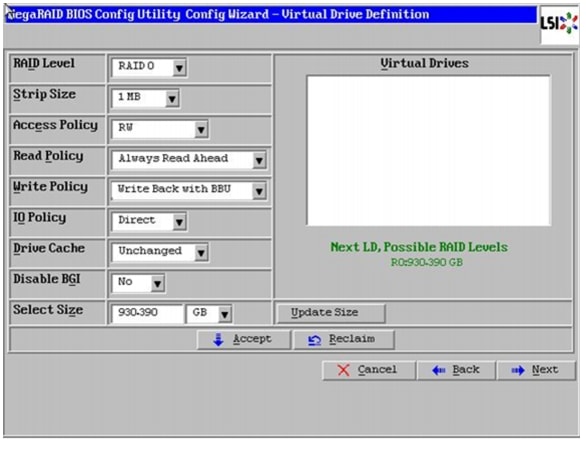
17.
Click Yes to save the configuration.
18.
In the Managing SSD Caching window, click Cancel as shown in Figure 52.
Figure 61 SSD Caching Window
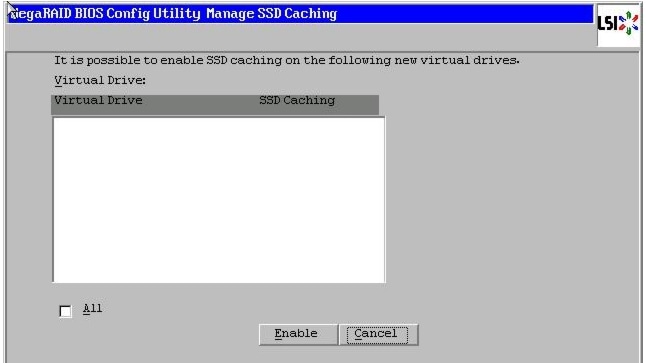
19.
Click Yes in the confirmation page.
20.
Set VD0 as the Boot Drive and click Go as shown in Figure 53.
Figure 62 Setting Virtual Drive as Boot Drive
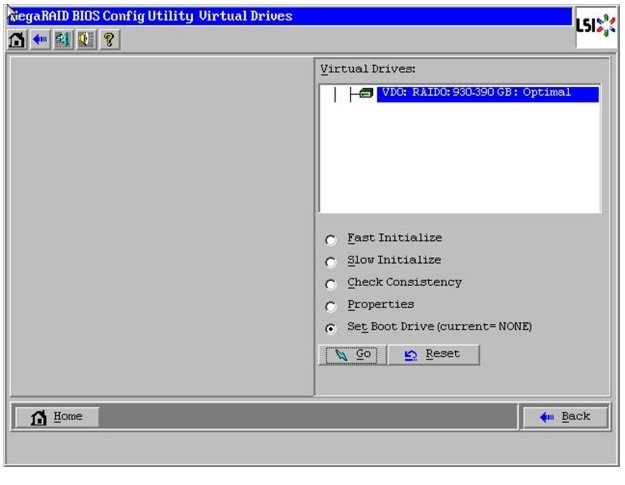
21.
Click Home.
22.
Review the configuration and click Exit.
Configuration of disks 3 to 24 are done using Linux based MegaCLI commands described in "Configuring Data Drives on DataNodes" section.
Installing Red Hat Linux 6.2 with KVM
The following section provides detailed procedures for installing Red Hat Linux 6.2.
There are multiple methods to install Red Hat Linux Operating System. The installation procedure described in this design guide uses KVM console and virtual media from Cisco UCS Manager.
1.
Log in to the Cisco UCS 6296 Fabric Interconnect and launch the Cisco UCS Manager application.
2.
Click the Equipment tab.
3.
In the navigation pane expand Rack-Mounts and Servers.
4.
Right-click on the Server and select KVM Console as shown in Figure 63.
Figure 63 Selecting KVM Console Option

5.
In the KVM window, select the Virtual Media tab as shown in Figure 64.
6.
Click Add Image button in the Client View selection window.
7.
Browse to the Red Hat Enterprise Linux Server 6.2 installer ISO image file.

Note
The Red Hat Enterprise Linux 6.2 DVD is assumed to be available on the client machine.
Figure 64 Adding an ISO Image
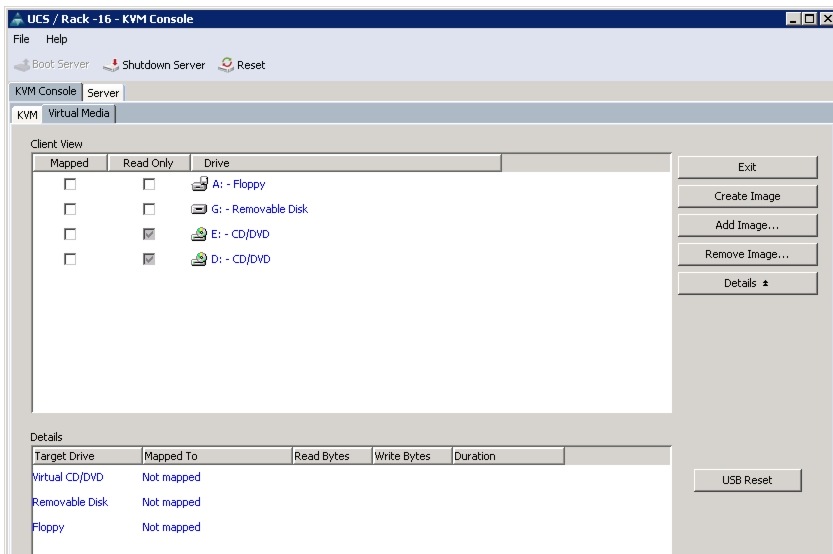
8.
Click Open to add the image to the list of virtual media.
9.
Check the Mapped check box for the image you just added as shown in Figure 65.
Figure 65 Mapping ISO Image
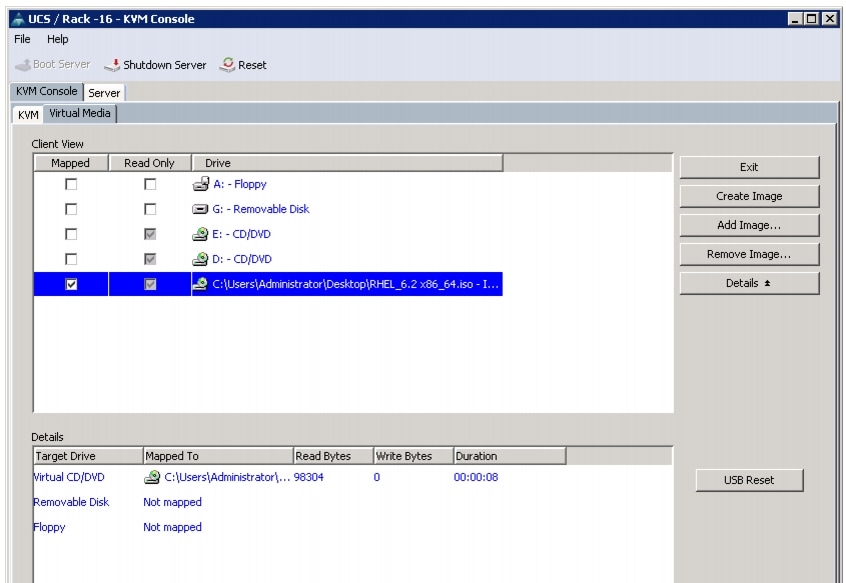
10.
In the KVM console, select the KVM tab to monitor the bootup.
11.
In the KVM console, click Boot Server.
12.
Click OK.
13.
Click OK to reboot the system.
On reboot, the server detects the presence of the Red Hat Enterprise Linux Server 6.2 install media.
14.
Select Install or Upgrade an Existing System option as shown in Figure 66.
Figure 66 Select Install Option

15.
Skip the Media test as the ISO Image is used for the installation.
16.
Click Next. The Red Hat Linux Welcome Screen appears.
17.
Select the Language for the installation.
18.
Click the Basic Storage Devices radio button.
19.
Click the Fresh Installation radio button.
20.
Enter the host name of the server and click Next.
21.
Click Configure Network. The Network Connections window appear.
22.
In the Network Connections window, select the Wired tab.
23.
Select the interface System eth0 and click Edit.
24.
Editing System eth0 appears as shown in Figure 67.
25.
Check the Connect automatically check box.
26.
Select Manual in the Method drop-down list.
27.
Click Add and enter IP Address, the netmask and the gateway.
For this demonstration, the following values have been used:
IP Address: 10.29.160.53
Netmask: 255.255.255.0
Gateway: 10.29.160.1
28.
Add DNS servers (optional).
29.
Click Apply.
Figure 67 Configuring Network for eth0
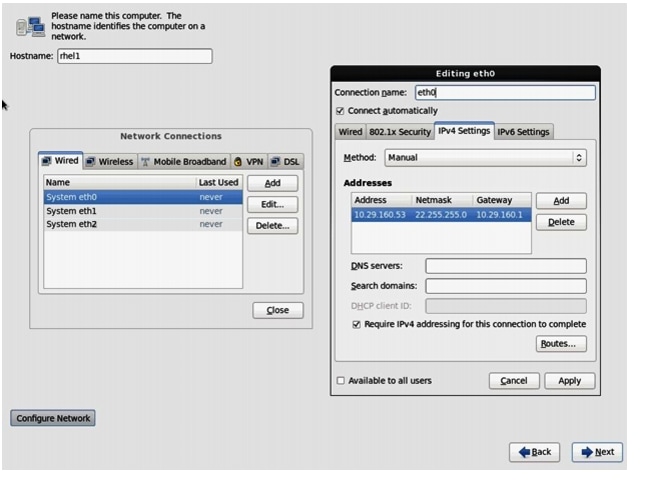
30.
Repeat the steps 26 to steps 32 to configure the network for the System eth1. The following values have been used (see Figure 68):
IP Address: 192.168.12.11
Netmask: 255.255.255.0
Figure 68 Configuring Network for eth1
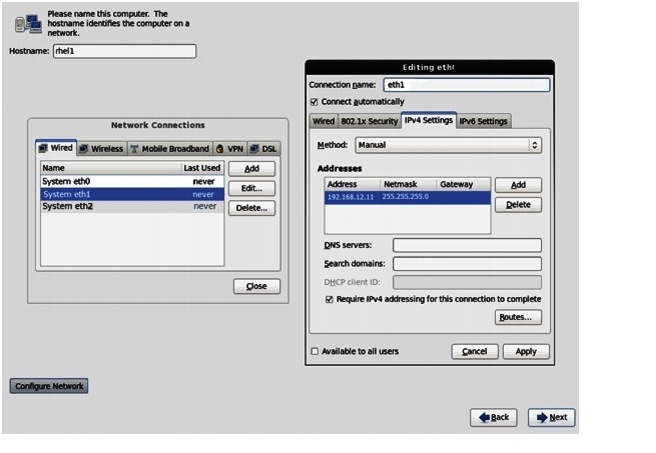
31.
Repeat the steps 26 to steps 32 to configure the network for System eth2. The following values have been used:
IP Address: 192.168.11.11
Netmask: 255.255.255.0
32.
Select the appropriate time zone.
33.
Enter the root password and click Next.
34.
Select Use All Space and click Next as shown in Figure 69.
35.
Choose an appropriate boot drive.
Figure 69 Selecting Install Option
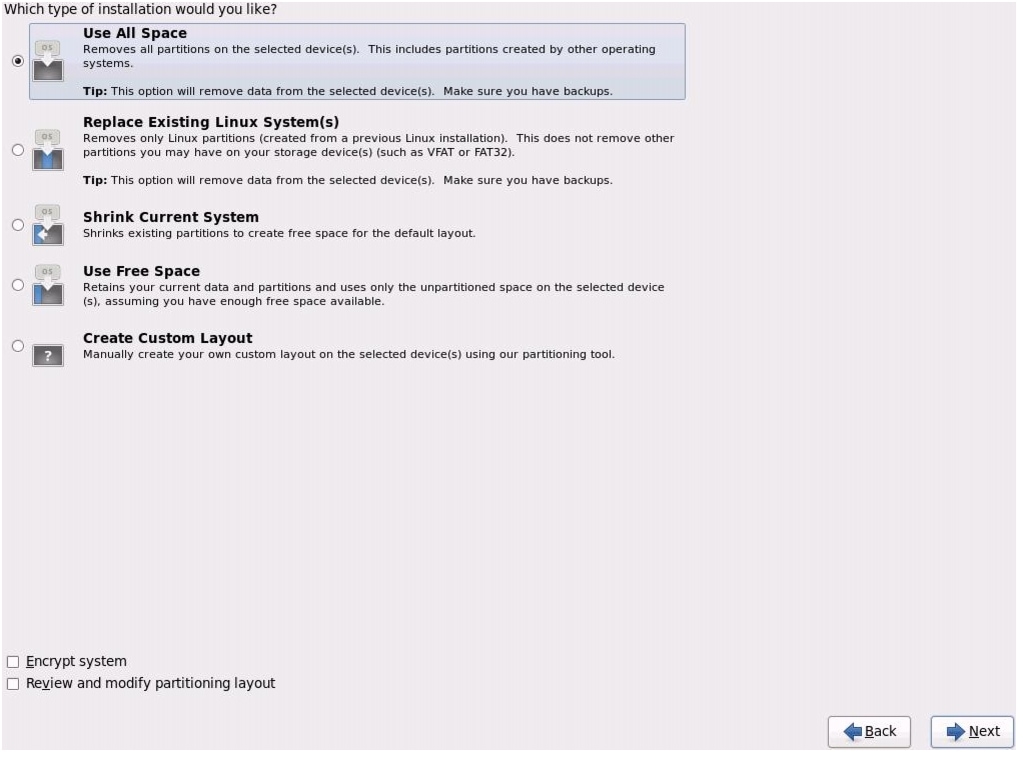
36.
Click Write changes to the disk and click Next.
37.
Select Basic Server and click Next as shown in Figure 70.
Figure 70 Selecting Type of Installation
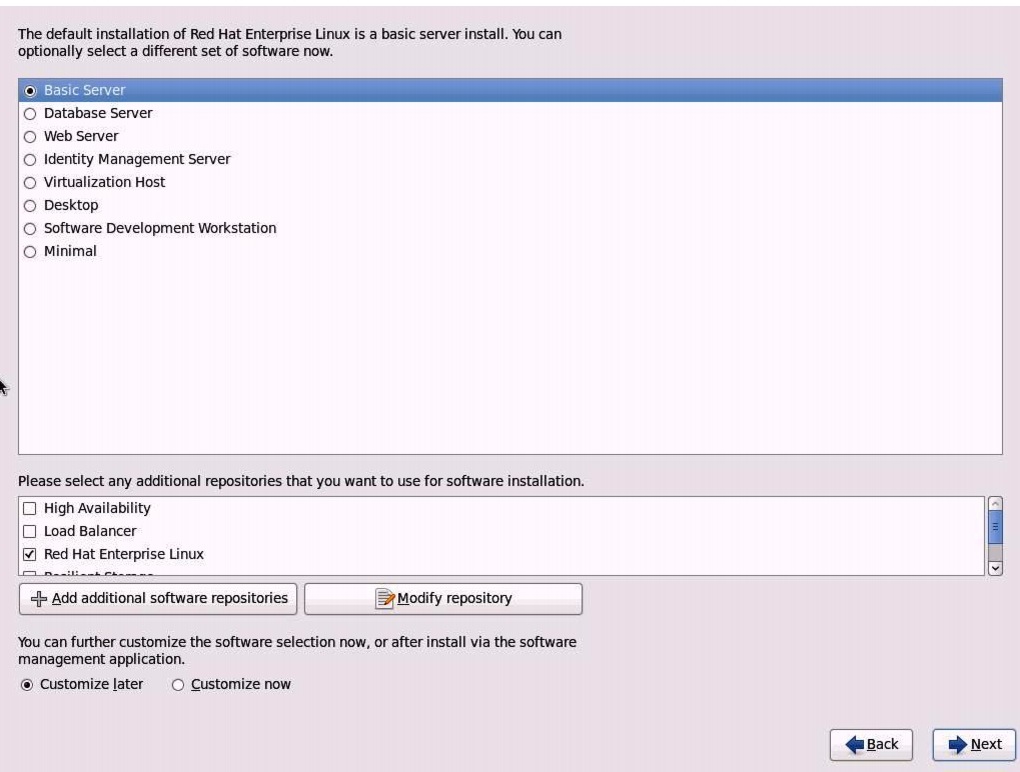
38.
After the installer has finished loading, it will continue with the installation.
39.
Reboot the system after the installation is complete.
Repeat the above steps (1 to 39) to install the Red Hat Linux on servers 2 through 64.

Note
You can automate the OS installation and configuration of the nodes through the Preboot Execution Environment (PXE) boot or through third party tools.
Table 5 describes the hostnames and their corresponding IP addresses.
Post OS Install Configuration
Choose one of the nodes of the cluster or a separate node as an Admin Node for management such as HDP installation, parallel shell, creating a local Red Hat repo and others. In this document, we have used rhel1 for management.
Setting Up Password-less Login
To manage all of the cluster nodes from the admin node we need to setup password-less login. It assists in automating common tasks with Parallel-SSH (pssh) and shell-scripts without having passwords.
Once Red Hat Linux is installed across all the nodes in the cluster, follow these steps in order to enable password less login across all the nodes.
1.
Login to the admin node (rhel1).
ssh 10.29.160.532.
Run the ssh-keygen command to create both public and private keys on the admin node.
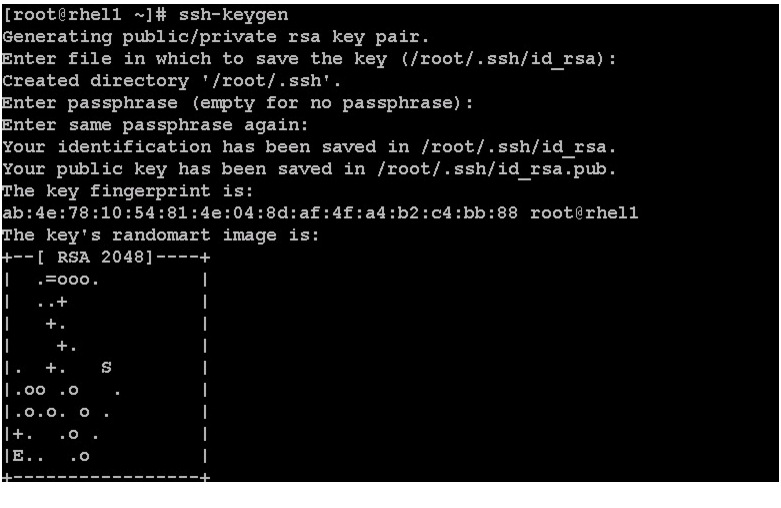
3.
Run the following commands from the admin node to copy the public key id_rsa.pub to all the nodes of the cluster. The .ssh-copy-id command appends the keys to the remote-host. .ssh/authorized_key.
for IP in {53..116}; do echo -n "$IP -> "; ssh-copy-id -i ~/.ssh/id_rsa.pub 10.29.160.$IP; done4.
Enter yes at the command prompt to continue connecting.
5.
Enter the password of the remote host to login.
Installing and Configuring Parallel SSH
Installing Parallel-SSH
Parallel-ssh is used to run commands on several hosts at the same time. It takes a file of hostnames and a few common ssh parameters as parameters, and executes the given command in parallel on the specified nodes.
1.
Download the pssh.
wget https://parallel-ssh.googlecode.com/files/pssh-2.3.1.tar.gzscp pssh-2.3.1.tar.gz rhel1:/root
2.
Run the following command to copy pssh-2.3.1.tar.gz to the admin node:
ssh rhel1tar xzf pssh-2.3.1.tar.gzcd pssh-2.3.1python setup.py install
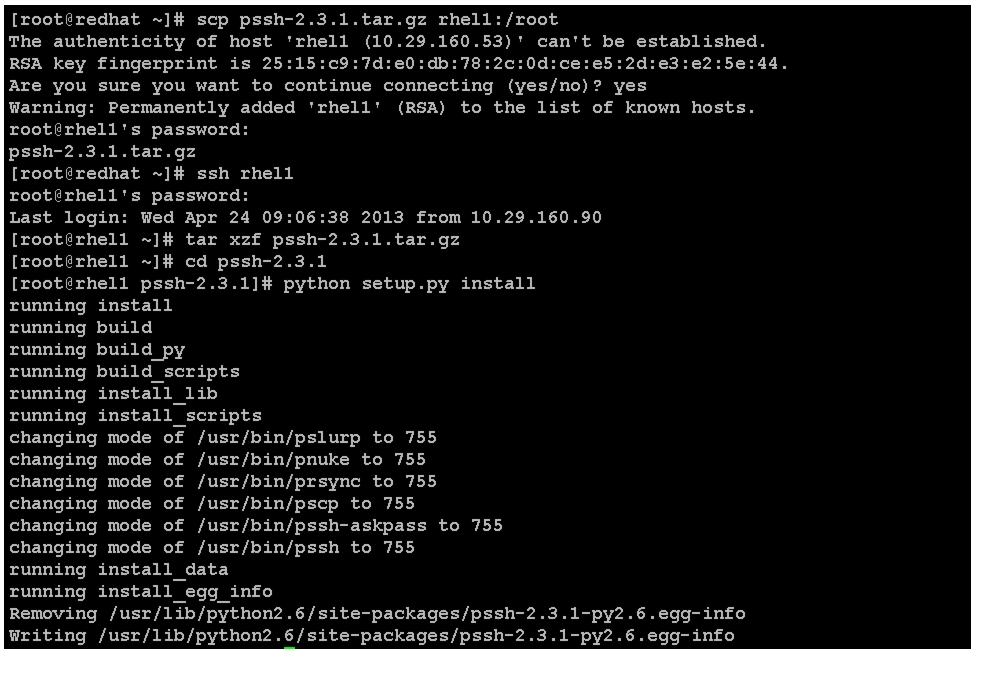
3.
Extract and install pssh on the admin node.
4.
Create a host file containing the IP addresses of all the nodes and all the DataNodes in the cluster. This file is passed as a parameter to pssh to identify the nodes and run the commands on them.
vi /root/allnodes# This file contains ip address of all nodes of the cluster#used by parallel-shell (pssh). For Details man pssh10.29.160.5310.29.160.5410.29.160.5510.29.160.5610.29.160.5710.29.160.5810.29.160.5910.29.160.6010.29.160.6110.29.160.6210.29.160.6310.29.160.6410.29.160.6510.29.160.6610.29.160.6710.29.160.68...10.29.160.116vi /root/datanodes10.29.160.5510.29.160.5610.29.160.5710.29.160.5810.29.160.5910.29.160.6010.29.160.6110.29.160.6210.29.160.6310.29.160.6410.29.160.6510.29.160.6610.29.160.6710.29.160.68...10.29.160.116Installing Cluster Shell
1.
Download cluster shell (clush) and install it on rhel1.
Cluster shell is available from the Extra Packages for Enterprise Linux (EPEL) repository.
wget http://dl.fedoraproject.org/pub/epel//6/x86_64/clustershell-1.6-1.el6.noarch.rpmscp clustershell-1.6-1.el6.noarch.rpm rhel1:/root/2.
Login to rhel1 and install cluster shell.
yum install clustershell-1.6-1.el6.noarch.rpm3.
Edit /etc/clustershell/groups file to include hostnames for all the nodes of the cluster.
For 64 node cluster all: rhel[1-64]
Note
Configuring EPEL repository is discussed in detail in another section.
Configuring /etc/hosts
Follow these steps to create the host file across all the nodes in the cluster:
1.
Run the following command to populate the host file with IP addresses and corresponding hostnames on the admin node (rhel1):
vi /etc/hosts127.0.0.1 localhost localhost.localdomain localhost4 localhost4.localdomain4::1 localhost localhost.localdomain localhost6 localhost6.localdomain6192.168.12.11 rhel1192.168.12.12 rhel2192.168.12.13 rhel3192.168.12.14 rhel4192.168.12.15 rhel5192.168.12.16 rhel6192.168.12.17 rhel7192.168.12.18 rhel8192.168.12.19 rhel9192.168.12.20 rhel10192.168.12.21 rhel11192.168.12.22 rhel12192.168.12.23 rhel13192.168.12.24 rhel14192.168.12.25 rhel15192.168.12.26 rhel16...192.168.12.74 rhel642.
Run the following command to deploy /etc/hosts from the admin node (rhel1) to all the nodes:
pscp -h /root/allnodes /etc/hosts /etc/hosts

Creating Red Hat Local Repository
To create a repository using RHEL DVD or ISO on the admin node (in this deployment rhel1 is used for this purpose), create a directory with all the required rpms, run the createrepo command and then publish the resulting repository.
1.
Login to rhel1 node, and run the following command to create a directory that would contain the repository:
mkdir -p /var/www/html/rhelrepo2.
Copy the contents of the Red Hat DVD to /var/www/html/rhelrepo.
3.
Alternatively, if you have access to a Red Hat ISO Image, copy the ISO file to rhel1.
scp rhel-server-6.2-x86_64-dvd.iso rhel1:/rootAssuming the Red Hat ISO file is located in your working directory.
mkdir -p /mnt/rhelisomount -t iso9660 -o loop /root/rhel-server-6.2-x86_64-dvd.iso /mnt/rheliso/4.
Copy the contents of the ISO to the /var/www/html/rhelrepo directory.
cp -r /mnt/rheliso/* /var/www/html/rhelrepo5.
Run the following command on the rhel1 to create a .repo file that enables the use of the yum command:
vi /var/www/html/rhelrepo/rheliso.repo[rhel6.2]name=Red Hat Enterprise Linux 6.2baseurl=http://10.29.160.53/rhelrepogpgcheck=0enabled=1
Note
The yum command based on the repo file requires httpd to be running on rhel1 so that the other nodes can access the repository.
6.
Copy the rheliso.repo to all the nodes of the cluster.
pscp -h /root/allnodes /var/www/html/rhelrepo/rheliso.repo /etc/yum.repos.d/
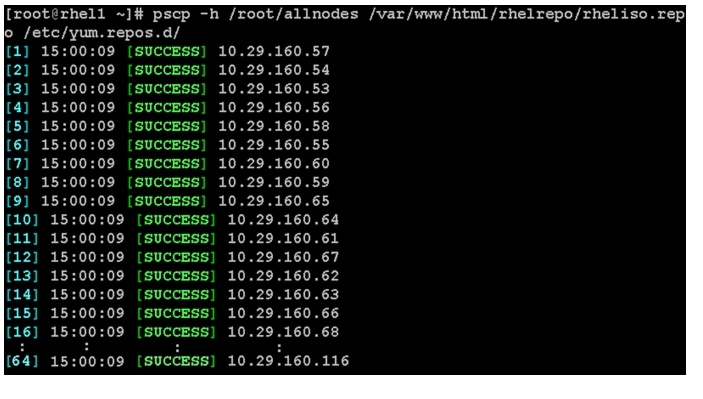
7.
To use the repository files on rhel1 without httpd, edit the baseurl of the repo file. etc/yum.repos.d/rheliso.repo to point repository location in the file system.
vi /etc/yum.repos.d/rheliso.repo[rhel6.2]name=Red Hat Enterprise Linux 6.2baseurl=file:///var/www/html/rhelrepogpgcheck=0enabled=18.
Run pssh -h /root/allnodes "yum clean all" command:
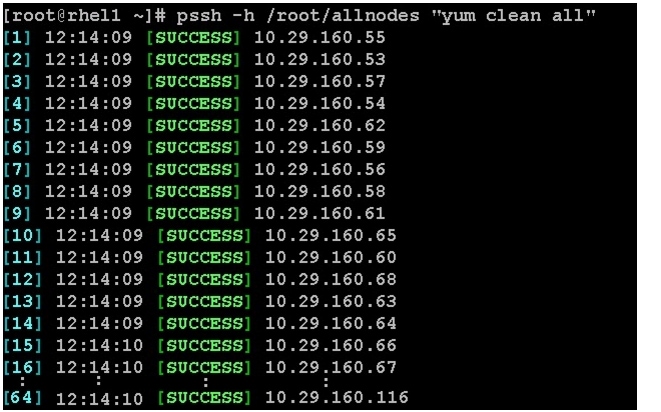
Creating the Red Hat Repository Database
1.
Install the createrepo package.
2.
Use the createrepo package to regenerate the repository database(s) for the local copy of the RHEL DVD contents.
3.
Purge the yum caches:
yum -y install createrepocd /var/www/html/rhelrepocreaterepo .yum clean all

Upgrading LSI driver
The latest LSI driver is essential for performance and bug fixes.
To download the latest LSI drivers, see:
1.
In the ISO image, the required driver kmod-megaraid_sas-v06.504.01.00.rpm can be located at: ucs-cxxx-drivers.1.5.1\Linux\Storage\LSI\92xx\RHEL\RHEL6.2

2.
Download and transfer kmod-megaraid_sas-v06.504.01.00.rpm driver to the admin node (rhel1).
3.
Run the following commands to install the rpm on all nodes of the cluster:
pscp -h /root/allnodes kmod-megaraid_sas-v06.504.01.00_rhel6.2-2.x86_64.rpm /root/
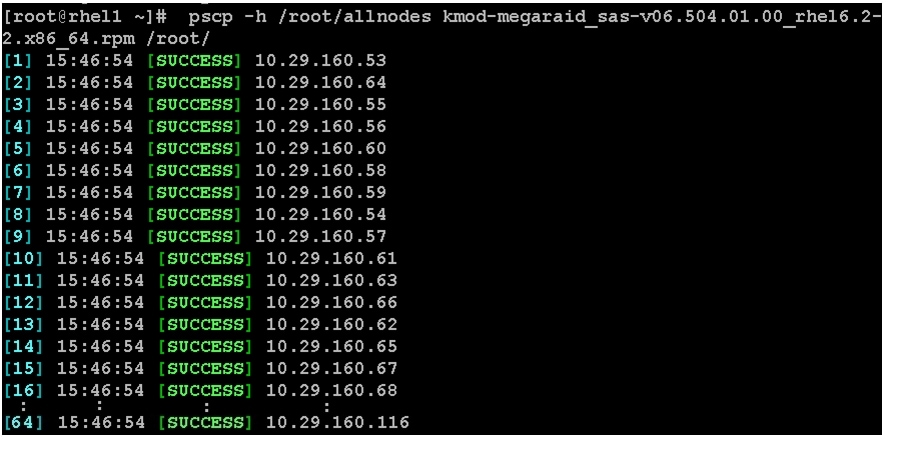
pssh -h /root/allnodes "rpm -ivh kmod-megaraid_sas-v06.504.01.00_rhel6.2-2.x86_64.rpm"
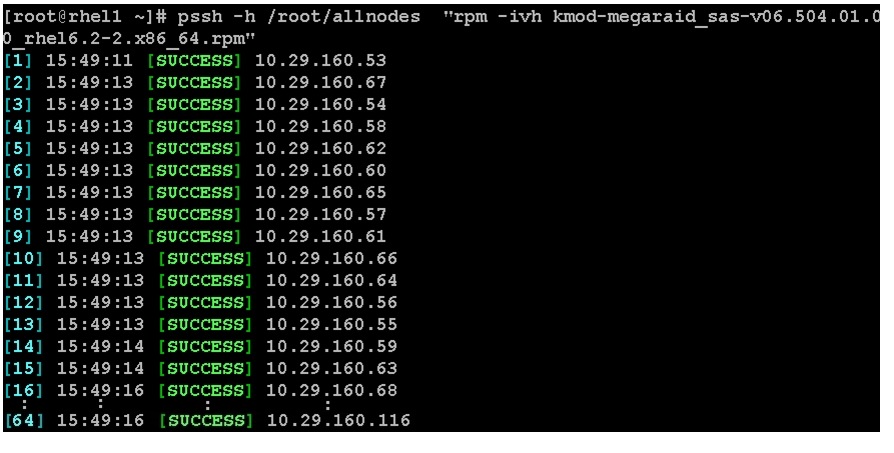
4.
Run the following command to verify the version of kmod-megaraid_sas driver is used on all the nodes (confirm all versions are same):
pssh -h /root/allnodes "modinfo megaraid_sas | head -5"

Installing httpd
1.
Install httpd on the admin node to host repositories.
The Red Hat repository is hosted using http on the admin node, and this machine is accessible by all the hosts in the cluster.
yum -y install httpd2.
Add the ServerName as 10.29.160.53:80, and make the necessary changes to the server configuration file.
/etc/httpd/conf/httpd.conf

3.
Run the following command to make sure that the httpd is able to read the repofiles:
chcon -R -t httpd_sys_content_t /var/www/html/rhelrepo4.
Run the following command to start httpd:
service httpd startchkconfig httpd onJDK Installation
Download Java SE 6 Development Kit (JDK)
Using a web browser, click on the following link:
http://www.oracle.com/technetwork/java/index.html
and download the latest Java™ SE 6 Development Kit (JDK™6).
Once the JDK6 package has been downloaded, place it in the /var/www/html/JDK/ directory.
Install JDK6 on All Node
Create the following script install_jdk.sh to install JDK:
Script install_jdk.sh
# Copy and install JDKcd /tmp/curl http://10.29.160.53/JDK/jdk-6u41-linux-x64.bin -O -Lsh ./jdk-6u41-linux-x64.bin -noregisterCopy script disable_services.sh to all nodes and run the script on all nodes:
pscp -h /root/pssh.hosts /root/install_jdk.sh /root/pssh -h /root/pssh.hosts "/root/install_jdk.sh"Extjs Installation
From a host connected to the Internet, download the Extjs and transfer it to rhel1.
wget http://s3.amazonaws.com/public-repo-1.hortonworks.com/HDP-UTILS-1.1.0.15/repos/centos6 /extjs/extjs-2.2-1.noarch.rpmCopy the extjs rpm to all nodes from the admin node.
pscp -h /root/allnodes /root/extjs-2.2-1.noarch.rpm /root/Install extjs on all nodes.
pssh -h /root/allnodes "yum -y install /root/extjs-2.2-1.noarch.rpm"NTP Configuration
The Network Time Protocol (NTP) is used to synchronize the time of all the nodes within the cluster. The Network Time Protocol daemon (ntpd) sets and maintains the system time of day in sync with the timeserver located in the admin node (rhel1). Configuring NTP is critical for any Hadoop Cluster. If server clocks in the cluster drift out of sync, serious problems can occur in the HBase and other services.

Note
Installing an internal NTP server keeps the cluster synchronized even when an outside NTP server is inaccessible.
1.
Configure /etc/ntp.conf on the admin node with the following contents:
vi /etc/ntp.confdriftfile /var/lib/ntp/driftrestrict 127.0.0.1restrict -6 ::1server 127.127.1.0fudge 127.127.1.0 stratum 10includefile /etc/ntp/crypto/pwkeys /etc/ntp/keys2.
Run the following commands to create /root/ntp.conf on the admin node and copy it to all the nodes:
vi /root/ntp.confserver 10.29.160.53driftfile /var/lib/ntp/driftrestrict 127.0.0.1restrict -6 ::1includefile /etc/ntp/crypto/pwkeys /etc/ntp/keys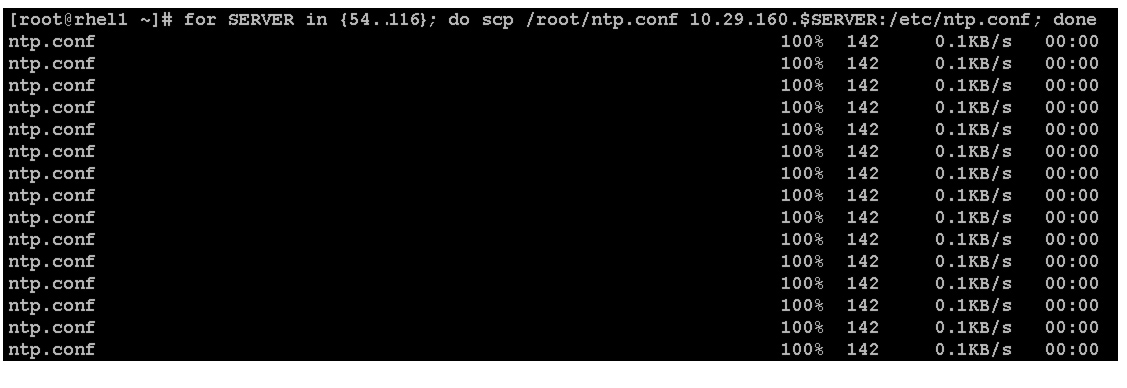
3.
Run the following command in the admin node (rhel1) to copy ntp.conf file from the admin node to /etc of all the nodes:
for SERVER in {54..116};do scp /root/ntp.conf10.29.160.$SERVER:/etc/ntp.conf; done
Note
Do not use pssh /root/allnodes command without editing the host file allnodes as it overwrites /etc/ntp.conf from the admin node.
4.
Run the following commands to synchronize the time and restart NTP daemon on all the nodes:
pssh -h /root/allnodes "yum install -y ntpdate"pssh -h /root/allnodes "service ntpd stop"pssh -h /root/allnodes "ntpdate rhel1"pssh -h /root/allnodes "service ntpd start"
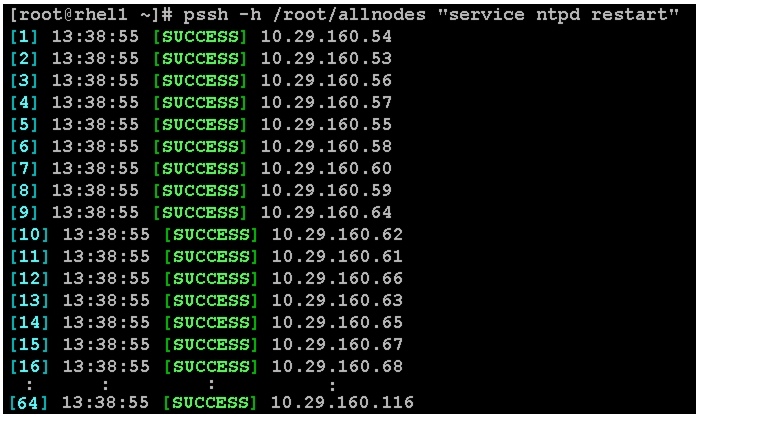
5.
Run the following command to restart the NTP daemon on all the reboots:
pssh -h /root/allnodes "chkconfig ntpd on"
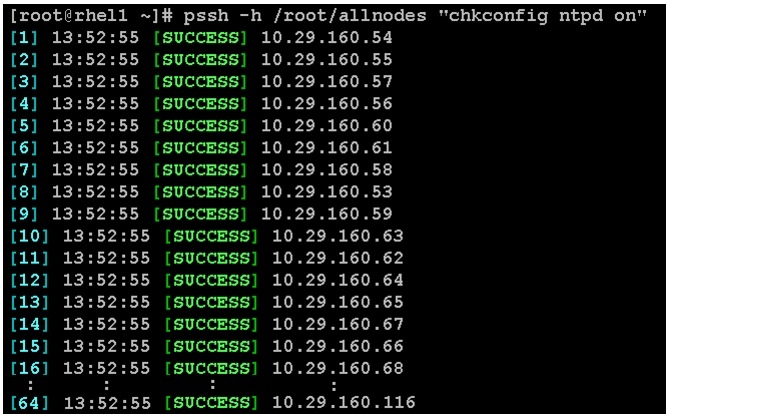
Enabling Syslog
Syslog must be enabled on each node to preserve logs regarding killed processes or failed jobs. Modern versions such as syslog-ng and rsyslog are possible, making it more difficult to ascertain if a syslog daemon is present.
Run any of the commands to confirm if the service is properly configured:
clush -B -a rsyslogd -vclush -B -a service rsyslog statusSetting Ulimit
On each node, ulimit -n specifies the number of inodes that can be opened simultaneously. With the default value of 1024, the system appears to be out of disk space and shows no inodes available. This value should be set to 64000 on every node.
Higher values are unlikely to result in an appreciable performance gain.
1.
For setting ulimit on Redhat, run the command Edit /etc/security/limits.conf and add the following lines:
root soft nofile 64000root hard nofile 640002.
To verify the ulimit setting, run the following command:
clush -B -a ulimit -nThe command should report 64000 as the ulimit.
Note
The ulimit values are applied on a new shell. Running the command on a node on an earlier instance of a shell shows old values.
Disabling SELinux
SELinux must be disabled during the HDP installation procedure and cluster setup. SELinux can be enabled after installation and while the cluster is running.
SELinux can be disabled by editing /etc/selinux/config and changing the SELINUX line to SELINUX=disabled.
1.
Run the following command to disable SELINUX on all nodes:
pssh -h /root/allnodes "sed -i 's/SELINUX=enforcing/SELINUX=disabled/g' /etc/selinux/config "
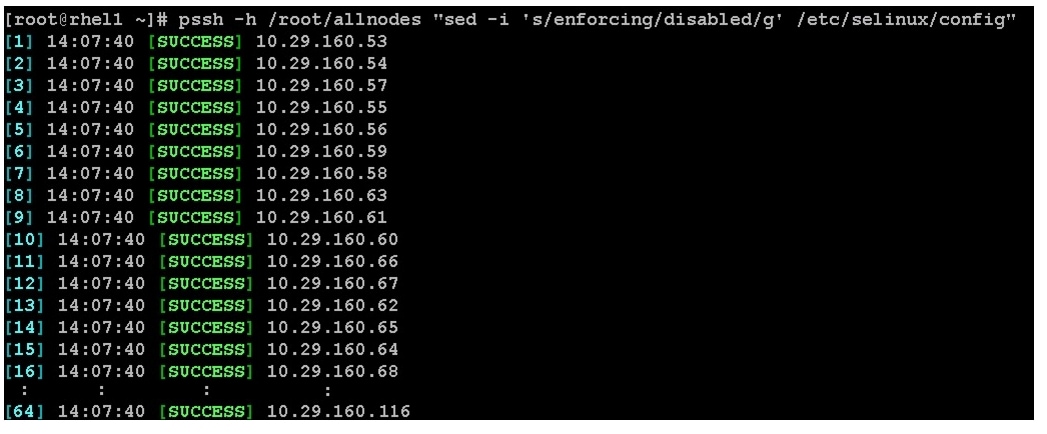
pssh -h /root/allnodes "setenforce 0"
Note
This command fails if SELinux is already disabled.
Setting TCP Retries Parameter
Adjusting the tcp_retries parameter for the system network enables faster detection of failed nodes. Given the advanced networking features of UCS, this is a safe and recommended change (failures observed at the Operating System layer are mostly serious rather than transitory). On each node, set the number of TCP retries to 5 can help detect unreachable nodes with less latency.
1.
Edit the file /etc/sysctl.conf and add the following line:
net.ipv4.tcp_retries2=52.
Save the file and run the following command.
clush -B -a sysctl -pDisabling the Linux Firewall
The default Linux firewall settings are far too restrictive for any Hadoop deployment. Since the Cisco UCS Big Data deployment is performed in the isolated network, there is no need to leave the iptables service running.
1.
Run the following commands to disable the iptables:
pssh -h /root/allnodes "service iptables stop"
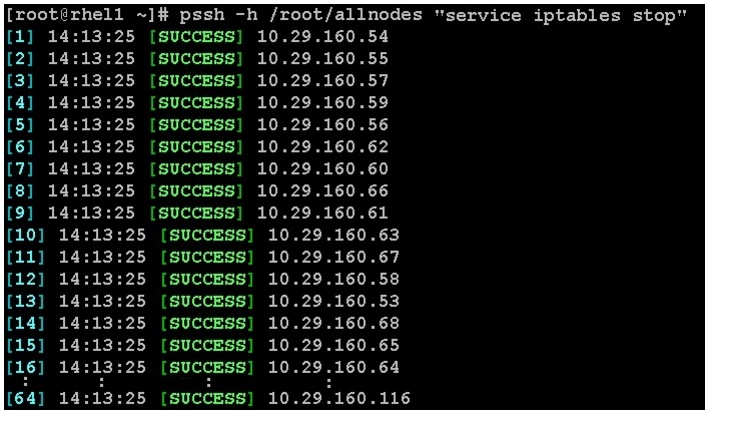
2.
Run the following command to check if the iptables are disabled:
pssh -h /root/allnodes "chkconfig iptables off"
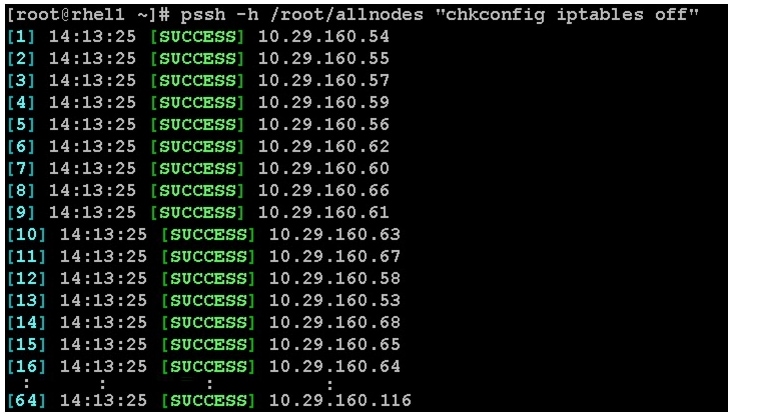
Configuring Data Drives on NameNode
This section provides the steps to configure data drives on the NameNode.
The first two disk drives are configured for the Operating System on the nodes, rhel1 and rhel2, as shown in "Configuring Disk Drives for Operating System on NameNode" section. The remaining disk drives can be configured similarly or by using MegaCli.
1.
From the LSI website http://www.lsi.com/support/Pages/Download-Results.aspx?keyword=9266-8i, download MegaCli and its dependencies and transfer the to the admin node.
scp /root/MegaCli64 rhel1:/root/scp /root/Lib_Utils-1.00-08.noarch.rpm rhel1:/root/scp /root/Lib_Utils2-1.00-01.noarch.rpm rhel1:/root/2.
To copy all the three files to all the nodes, run the following commands:
pscp -h /root/allnodes /root/MegaCli64 /root/
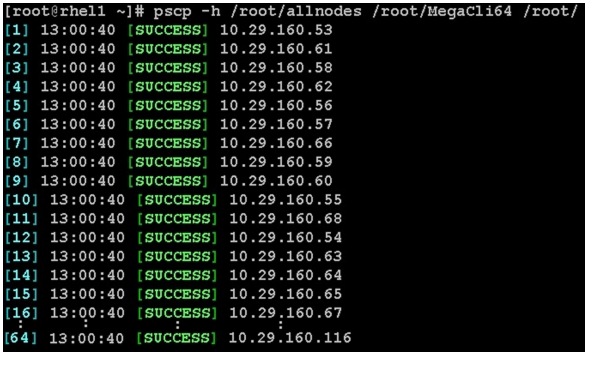
pscp -h /root/allnodes /root/Lib_Utils* /root/
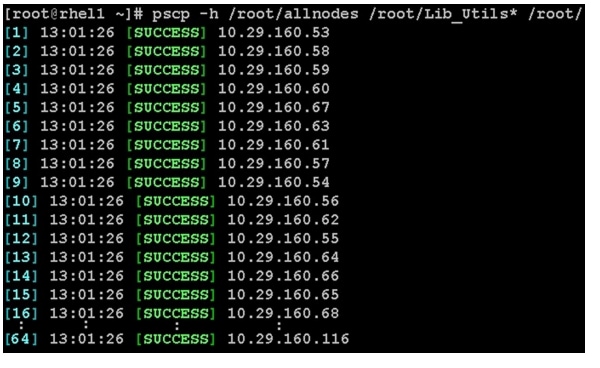
3.
Run the following command to install the rpms on all the nodes:
pssh -h /root/allnodes "rpm -ivh Lib_Utils*"
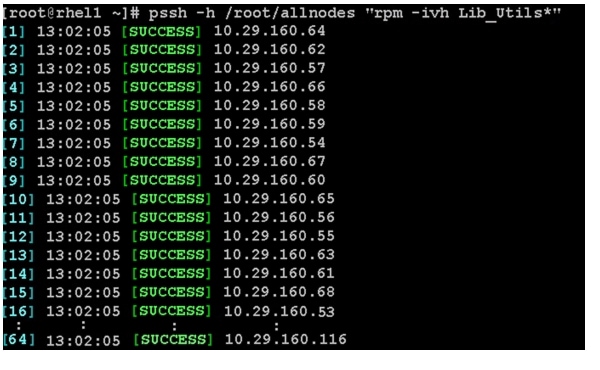
4.
Run the following script as root user on NameNode and Secondary NameNode to create the virtual drives.
vi /root/raid1.sh./MegaCli64 -cfgldadd r1[$1:3,$1:4,$1:5,$1:6,$1:7,$1:8,$1:9,$1:10,$1:11,$1:12,$1:13,$1:14,$1:15,$1:16,$1 :17,$1:18,$1:19,$1:20,$1:21,$1:22,$1:23,$1:24] wb ra nocachedbadbbu strpsz1024 -a0The above script requires enclosure ID as a parameter. Run the following command to get enclousure id../MegaCli64 pdlist -a0 | grep Enc | grep -v 252 | awk '{print $4}' | sort | uniq -c | awk '{print $2}'chmod 755 raid1.shRun MegaCli script as follows./raid1.sh <EnclosureID obtained by running the command above>WB: Write backRA: Read AheadNoCachedBadBBU: Do not write cache when the BBU is bad.Strpsz1024: Strip Size of 1024K
Note
The command above will not override any existing configuration. To clear and reconfigure the existing configurations, see Embedded MegaRAID Software Users Guide available at: www.lsi.com.
Configuring the Filesystem for NameNodes
To Configure the filesystem for NameNodes, run the following script:
vi /root/driveconf.sh#!/bin/bashdisks_count=`lsblk -id | grep sd | wc -l`if [ $disks_count -eq 2 ]; thenecho "Found 2 disks"elseecho "Found $disks_count disks. Expecting 2. Exiting.."exit 1fi[[ "-x" == "${1}" ]] && set -x && set -v && shift 1for X in /sys/class/scsi_host/host?/scandoecho '- - -' > ${X}donefor X in /dev/sd?doecho $Xif [[ -b ${X} && `/sbin/parted -s ${X} print quit|/bin/grep -c boot` -ne 0 ]]thenecho "$X bootable - skipping."continueelseY=${X##*/}1/sbin/parted -s ${X} mklabel gpt quit/sbin/parted -s ${X} mkpart 1 6144s 100% quit/sbin/mkfs.xfs -f -q -l size=65536b,lazy-count=1,su=256k -d sunit=1024,swidth=6144 -r extsize=256k -L ${Y} ${X}1(( $? )) && continue/bin/mkdir -p /HDP/${Y}(( $? )) && continue/bin/mount -t xfs -o allocsize=128m,noatime,nobarrier,nodiratime ${X}1 /HDP/${Y}(( $? )) && continueecho "LABEL=${Y} /HDP/${Y} xfs allocsize=128m,noatime,nobarrier,nodiratime 0 0" >> /etc/fstabfidoneConfiguring Data Drives on DataNodes
This section provides the steps to configure data drives on DataNodes.
The first disk drive is configured for the Operating System on all the DataNodes, rhel3 to rhel64 as shown in "Configuring Disk Drives for Operating System on DataNodes" section. The remaining disk drives can be configured similarly or by using MegaCli.
Run the following command from the admin node to create the virtual drives with RAID 0 configurations on all the DataNodes.
pssh -h /root/datanodes "./MegaCli64 -cfgeachdskraid0 WB RA direct NoCachedBadBBU strpsz1024 -a0"WB: Write back
RA: Read Ahead
NoCachedBadBBU: Do not write cache when the BBU is bad
Strpsz1024: Strip Size of 1024K

Note
The above command will not override existing configurations. To clear and reconfigure the existing configurations, see Embedded MegaRAID Software Users Guide available at: www.lsi.com.
Configuring the Filesystem for DataNodes
This section describes the procedure to configure the filesystem for DataNodes.
1.
On the Admin node, create a file containing the following script.
To create partition tables and file systems on the local disks of each nodes, run the following script as the root user on all the nodes.
vi /root/driveconf.sh#!/bin/bashdisks_count=`lsblk -id | grep sd | wc -l`if [ $disks_count -eq 24 ]; thenecho "Found 24 disks"elseecho "Found $disks_count disks. Expecting 24. Exiting.."exit 1fi[[ "-x" == "${1}" ]] && set -x && set -v && shift 1for X in /sys/class/scsi_host/host?/scandoecho '- - -' > ${X}donefor X in /dev/sd?doecho $Xif [[ -b ${X} && `/sbin/parted -s ${X} print quit|/bin/grep -c boot` -ne 0 ]]thenecho "$X bootable - skipping."continueelseY=${X##*/}1/sbin/parted -s ${X} mklabel gpt quit/sbin/parted -s ${X} mkpart 1 6144s 100% quit/sbin/mkfs.xfs -f -q -l size=65536b,lazy-count=1,su=256k -d sunit=1024,swidth=6144 -r extsize=256k -L ${Y} ${X}1(( $? )) && continue/bin/mkdir -p /HDP/${Y}(( $? )) && continue/bin/mount -t xfs -o allocsize=128m,noatime,nobarrier,nodiratime ${X}1 /HDP/${Y}(( $? )) && continueecho "LABEL=${Y} /HDP/${Y} xfs allocsize=128m,noatime,nobarrier,nodiratime 0 0" >> /etc/fstabfidone2.
Run the following command to copy driveconf.sh to all the DataNodes.
pscp -h /root/datanodes /root/driveconf.sh /root/3.
Run the following command from the admin node to run the script across all DataNodes.
pssh -h /root/datanodes "./driveconf.sh"
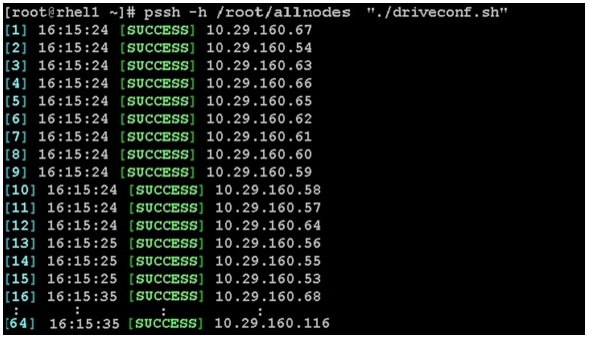
Installing HDP
HDP is an enterprise grade, hardened Hadoop distribution. HDP combines Apache Hadoop and its related projects into a single tested and certified package. It offers the latest innovations from the open source community with the testing and quality you expect from the enterprise quality software. HPD components are depicted in Figure 71.
Figure 71 HDP Components
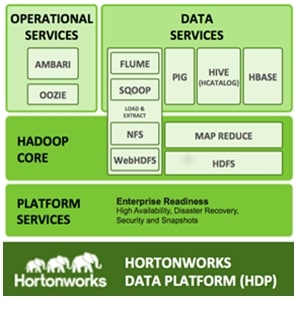
Prerequisites for HDP Installation
This section details the prerequisites for HDP installation such as setting up of EPEL and HDP Repo.
Hortonworks and EPEL Repo
From a host connected to the Internet, download the EPEL and Hortonworks repositories as shown below and transfer it to rhel1.
1.
Download EPEL Repository from the system connected to the Internet.
mkdir -p /tmp/Hortonworkscd /tmp/Hortonworksrpm -Uvh http://download.fedoraproject.org/pub/epel/6/x86_64/epel-release-6-8.noarch.rpmreposync -r epel2.
Download Hortonworks HDP Repo
wget http://public-repo-1.hortonworks.com/HDP/centos6/HDP-1.3.0.0-centos6-rpm.tar.gz3.
Download Hortonworks HDP-Utils Repo
wget http://public-repo-1.hortonworks.com/HDP-UTILS-1.1.0.15/repos/centos6/HDP-UTILS-1. 1.0.15-centos6.tar.gz4.
Download Ambari Repo
wget http://public-repo-1.hortonworks.com/ambari/centos6/ambari-1.2.3.7-centos6.tar.gz5.
Copy the repository directory to admin node
scp -r /tmp/Hortonworks/ rhel1:/var/www/html6.
Extract the files
login to rhel1cd /var/www/html/Hortonworkstar -zxvf HDP-1.3.0.0-centos6-rpm.tar.gztar -zxvf HDP-UTILS-1.1.0.15-centos6.tar.gztar -zxvf ambari-1.2.3.7-centos6.tar.gz7.
Create the hdp.repo file with following contents:
vi /etc/yum.repos.d/hdp.repo[HDP-1.3.0.0.]name=Hortonworks Data Platform Version - HDP-1.3.0.0baseurl=http://10.29.160.53/Hortonworks/HDP/centos6/1.x/GA/1.3.0.0/gpgcheck=0enabled=1priority=18.
Create the hdp-utils.repo file with following contents:
vi /etc/yum.repos.d/hdp-utils.repo[HDP-UTILS-1.1.0.15]name=Hortonworks Data Platform Version -HDP-UTILS-1.1.0.15baseurl=http://10.29.160.53/Hortonworks/HDP-UTILS-1.1.0.15/repos/centos6gpgcheck=0enabled=1priority=19.
Create the Ambari repo file with following contents:
vi /etc/yum.repos.d/ambari.repo[Updates-ambari-1.2.3.7]name=ambari-1.2.3.7 - Updatesbaseurl=http://rhel1/Hortonworks/ambari/centos6/1.x/updates/1.2.3.7gpgcheck=0enabled=1priority=110.
Create epel.repo
cd /var/www/html/Hortonworks/epelcreaterepo .vi /etc/yum.repos.d/epel.reponame=Extra Packages for Enterprise Linux 6 - $basearchbaseurl=http://rhel1/Hortonworks/epel/enabled=1gpgcheck=0priority=1From the admin node copy the repo files to /etc/yum.repos.d/ of all the nodes of the cluster.
pscp -h /root/allnodes /etc/yum.repos.d/hdp* /etc/yum.repos.d/pscp -h /root/allnodes /etc/yum.repos.d/ambari.repo /etc/yum.repos.d/pscp -h /root/allnodes /etc/yum.repos.d/epel.repo /etc/yum.repos.d/HDP Installation
To install HDP, issue the following CLI commands:
Install and Setup Ambari Server on rhel1
yum install ambari-serverSetup Ambari Server
ambari-server setup -j $JAVA_HOME
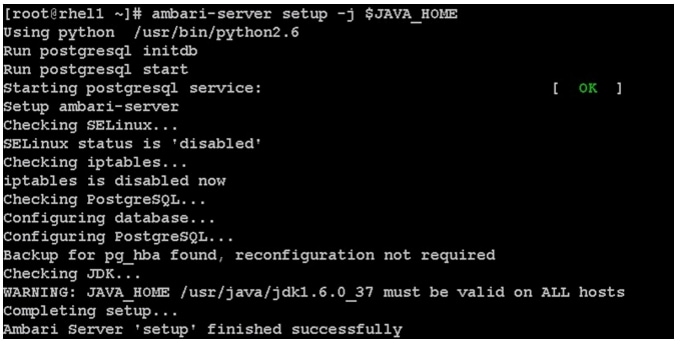
Configure Ambari Server to use Local Repository
Edit redhat6 and centos6 sections of the Ambari repoinfo.xml to point to local repository.
vi /var/lib/ambari-server/resources/stacks/HDPLocal/1.3.0/repos/repoinfo.xmlReplace the xml element <os type="redhat6"> .. </os> with<os type="redhat6"><repo><baseurl>http://10.29.160.53/Hortonworks/HDP/centos6/1.x/GA/1.3.0.0</baseurl><repoid>HDP-1.3.0</repoid><reponame>HDP</reponame></repo><repo><baseurl>http://10.29.160.53/Hortonworks/epel</baseurl><repoid>HDP-epel</repoid><reponame>HDP-epel</reponame><mirrorslist><![CDATA[http://mirrors.fedoraproject.org/mirrorlist?repo=epel-6&arch=$basear ch]]></mirrorslist></repo></os>Replace the xml element <os type="centos6"> .. </os> with<os type="centos6"><repo><baseurl>http://10.29.160.53/Hortonworks/HDP/centos6/1.x/GA/1.3.0.0</baseurl><repoid>HDP-1.3.0</repoid><reponame>HDP</reponame></repo><repo><baseurl>http://10.29.160.53/Hortonworks/epel</baseurl><repoid>HDP-epel</repoid><reponame>HDP-epel</reponame><mirrorslist><![CDATA[http://mirrors.fedoraproject.org/mirrorlist?repo=epel-6&arch=$basear ch]]></mirrorslist></repo></os>Start Ambari Server
ambari-server startConfirm Ambari Server Startup
ps -ef | grep ambari-serverLogin to Ambari Server
Once the Ambari service has been started, access the Ambari Install Wizard through the browser.
1.
Go to http://<ip address for rhel1>:8080.
2.
Login to the Ambari Server using the default username/password as admin/admin, which can be changed at a later period of time.
Create Cluster Name
Follow these steps to create the cluster name:
1.
In the Ambari Server home page, enter Cisco_HDP in the name field.
Figure 72 Apache Ambari - Home Page
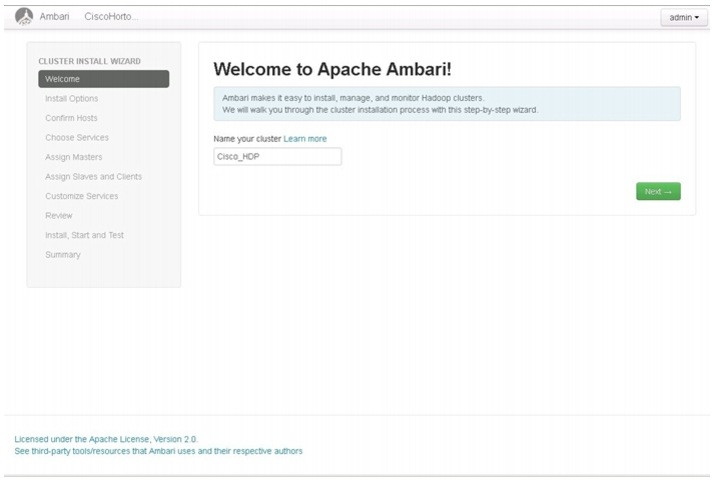
HDP Cluster Installation
In order to build a cluster, the install wizard needs to have a general information about how the cluster needs to be set up. For this, you need to provide the Fully Qualified Domain Name (FQDN) of each one of the hosts. The wizard also needs to access the private key file that was created in "Setting Up Password-less Login" section. It uses these to locate all the hosts in the system and to access and interact with them securely.
1.
Use the Target Hosts text box to enter the list of host names, one by one. You can also give a range within the brackets to indicate larger sets of hosts.
2.
Select the option Provide your SSH Private Key in the Ambari cluster install wizard.
a.
Copy the contents of the file /root/.ssh/id_rsa on rhel1 and paste it in the text area provided by the Ambari cluster install wizard.

Note
Make sure there is no extra white space after the text-----END RSA PRIVATE KEY-----
Figure 73 Copying Contents from /root/.ssh/id_rsa
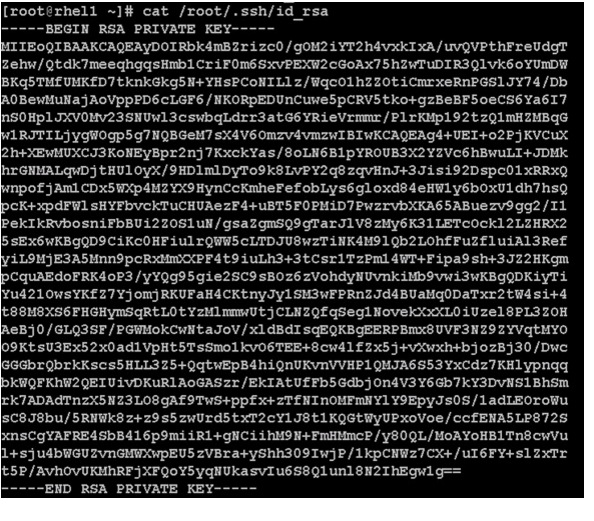
3.
Check the check boxes Use Local Software Repository and path to 64-bit JDK.
4.
Provide a path to java install directory.
5.
Click Register and Confirm to continue.
Figure 74 Confirming the HDP Installation
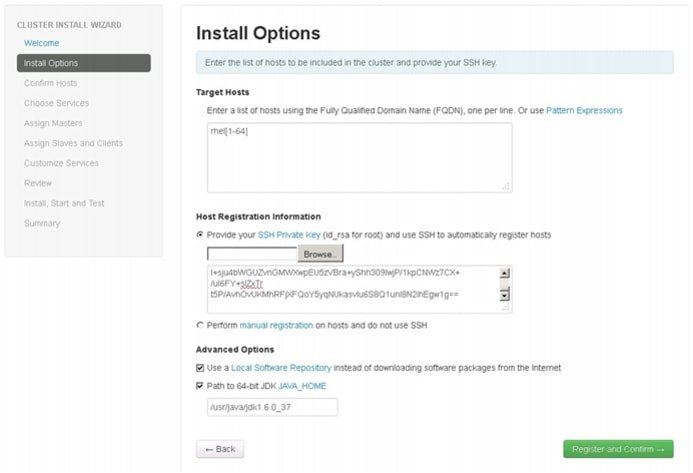
Host Name Pattern Expressions
Figure 75 shows a list of target host names using pattern expressions.
Figure 75 Host Name Pattern Expressions
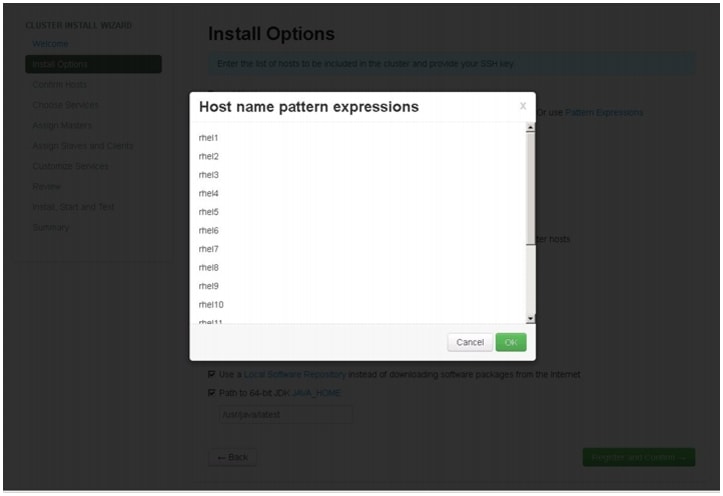
Confirming Hosts
This screen allows you to make sure that the Ambari server has located all the required hosts for the cluster and to make sure that the hosts have correct directories, packages, and processes to continue the installation process.
You can remove the undesired hosts that were selected by the Ambari server. To remove all the undesired hosts, check the appropriate check boxes provided against each of the hosts and then click
. To remove a single host, click
.
Figure 76 Confirming Hosts to be Included in the Cluster
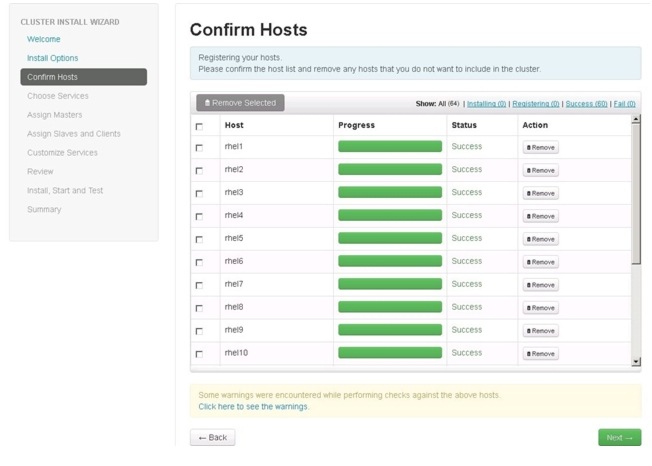
Choose Services
HDP is made up of a number of components. See Understand the Basics for more information.
1.
Select all to preselect all items.
2.
When you have made your selections, click Next.
Figure 77 Choosing Services for the Cluster
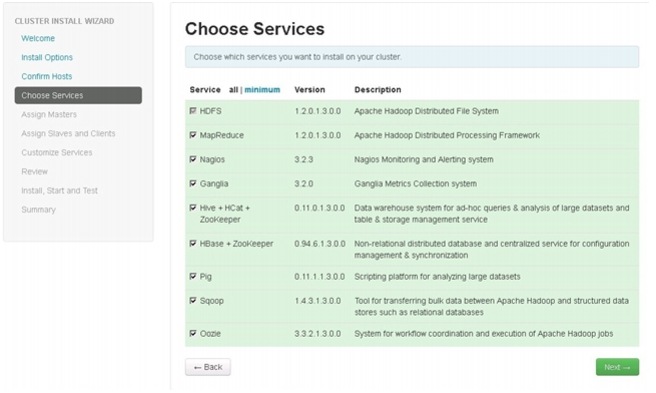
Assign Masters
The Ambari install wizard attempts to assign the master nodes for various services that have been selected for the appropriate hosts in the cluster. Figure 78 shows the current service assignments by the host, the hostname and its number of CPU cores and RAM size.
1.
Reconfigure the service assignment to match the Table 6:

Note
On a small cluster (<16 nodes), consolidate all the master services to run on a single node.
2.
Click Next.
Figure 78 Assigning Master Components
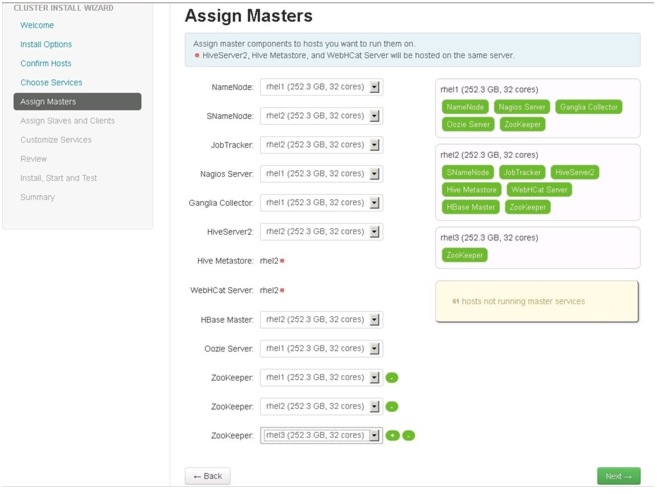
Assign Slaves and Clients
The Ambari install wizard attempts to assign the slave components (DataNodes, TaskTrackers, and RegionServers) to appropriate hosts in the cluster. Reconfigure the service assignment to match Figure 79:
1.
Assign DataNode, TaskTracker, RegionServer nodes rhel3 to rhel64.
2.
Assign Client to all nodes.
3.
Click Next.
Figure 79 Assigning Slave and Client Components to Hosts
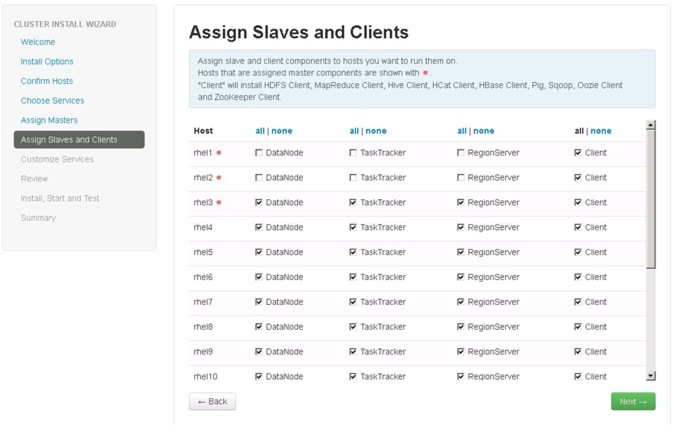
Customize Services
Customize Services window in the cluster install wizard presents a number of configuration settings to manage Hadoop components. The configuration settings can be done based on your requirements under each of the tabs as shown in Figure 132. This window shows the default settings for each of the configuration options, but you can modify the settings to meet specific requirements.
Following are the configurations available in the cluster install wizard:
•
HDFS
•
Misc
The following sections provide details of each of these configurations.
HDFS
Update the HDFS configurations as shown in Table 7, and Figure 80 and Figure 81:
Table 7 HDFS Configurations
NameNode Java Heap Size
4GB
Reserved space for HDFS
4GB
DataNode Volumes Failure Toleration
5
Figure 80 Customize Services - HDFS Configuration Window Part 1
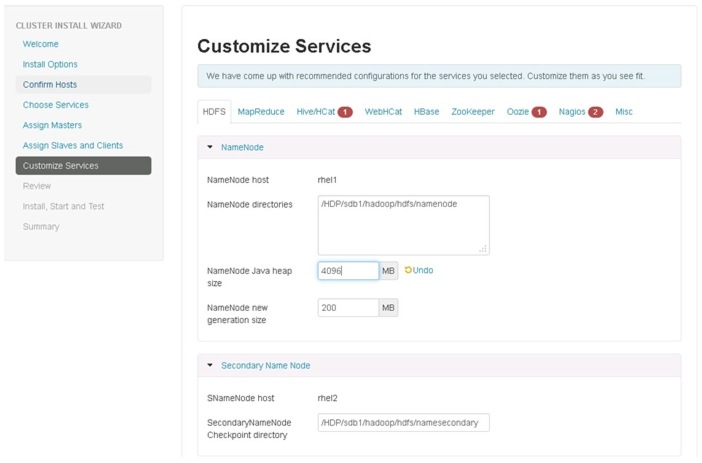
Figure 81 Customize Services - HDFS Configuration Window Part 2
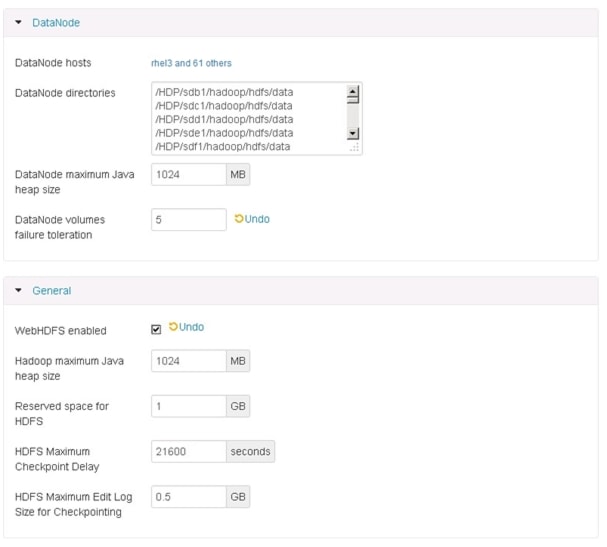
MapReduce
Update the MapReduce configuration as shown in Table 8, and Figure 82 and Figure 83:
Figure 82 Customize Services - MapReduce Configuration Window Part 1
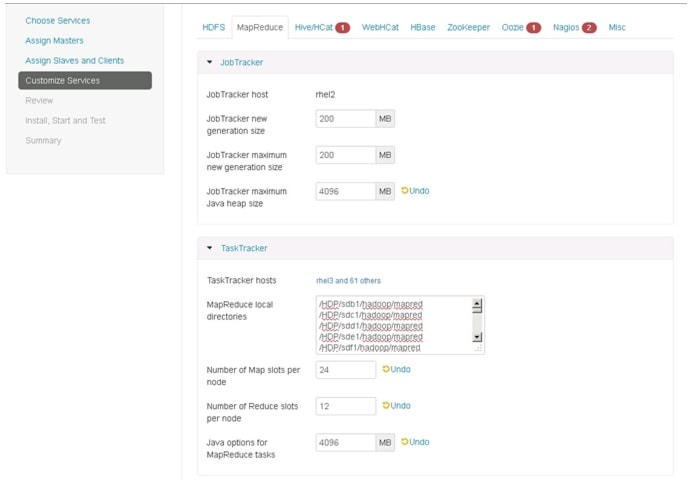
Figure 83 Customize Services - MapReduce Configuration Window Part 2
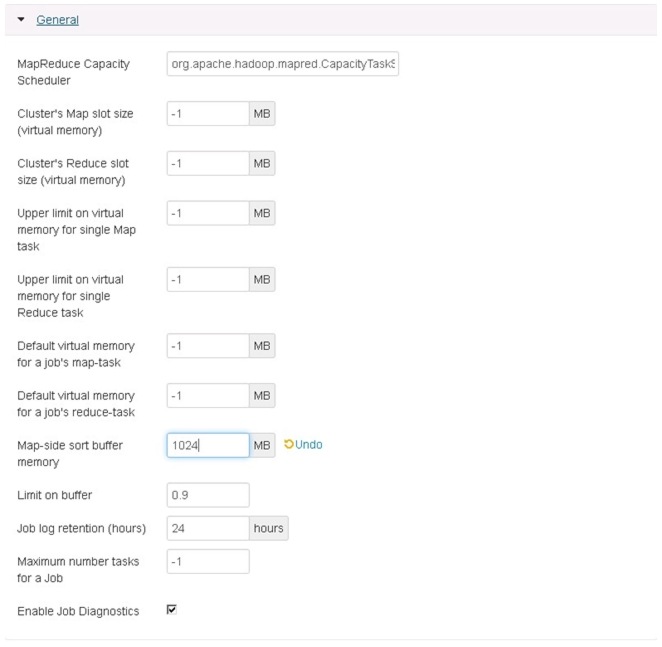
Hive/HCat
Enter the hive database password as per the organizational policy as shown in Figure 84.
Figure 84 Customize Services - Hive/HCat Window
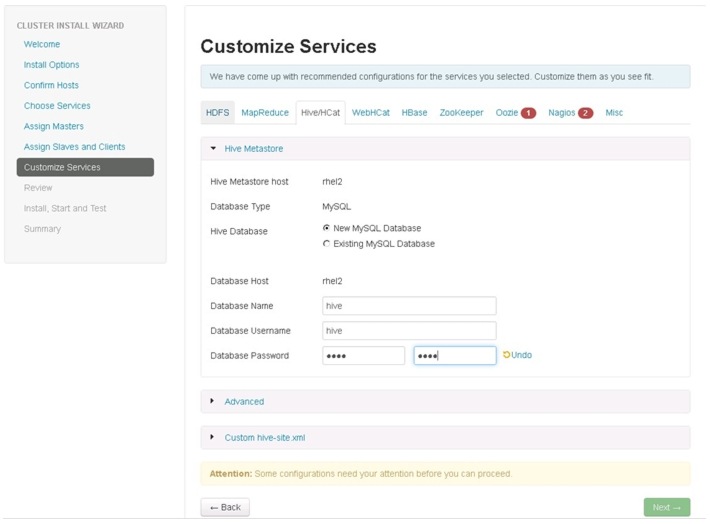
WebHCat
We can restore the default settings, no changes needed as shown in Figure 85.
Figure 85 Customize Services - WebHcat Configuration
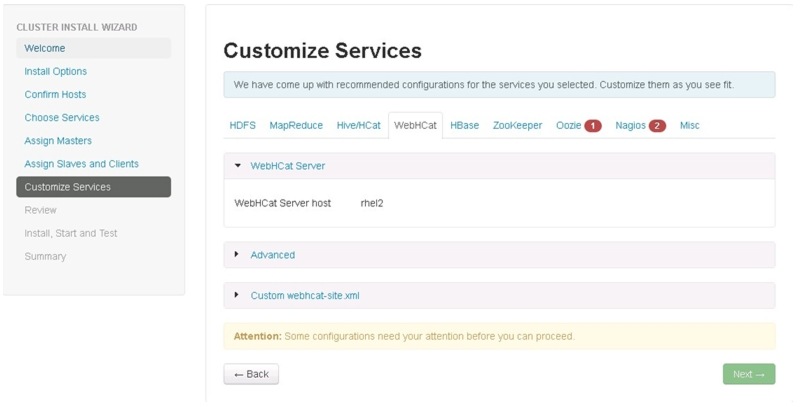
HBase
Update the HBase configurations as shown in Table 9, and Figure 86:
Table 9 HBase Configurations
HBase Master Maximum Java Heap Size
4GB
HBase RegionServers Maximum Java Heap Size
32GB
Figure 86 Customize Services - HBase Configuration Window
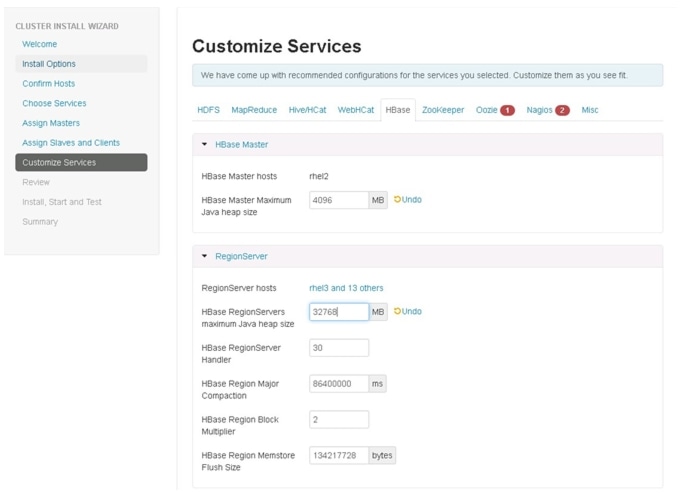
ZooKeeper
We can restore the default settings in the ZooKeeper window, no changes needed as shown in Figure 85.
Figure 87 Customize Services - ZooKeeper Window
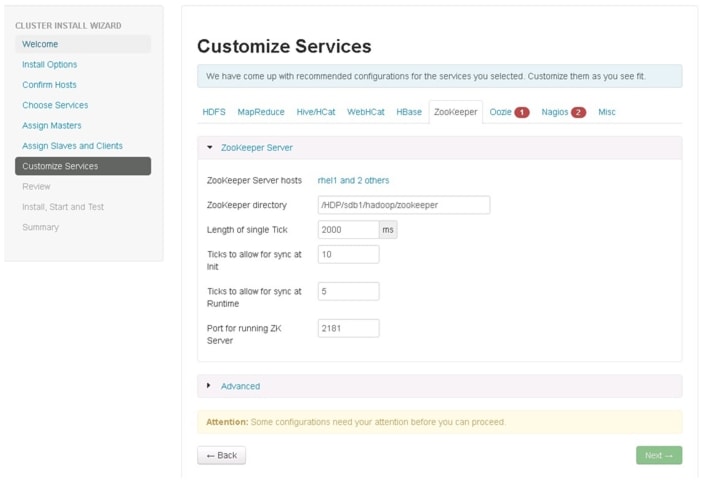
Oozie
Enter the Oozie database password as per the organizational policy as shown in Figure 88.
Figure 88 Customize Services - Oozie Window
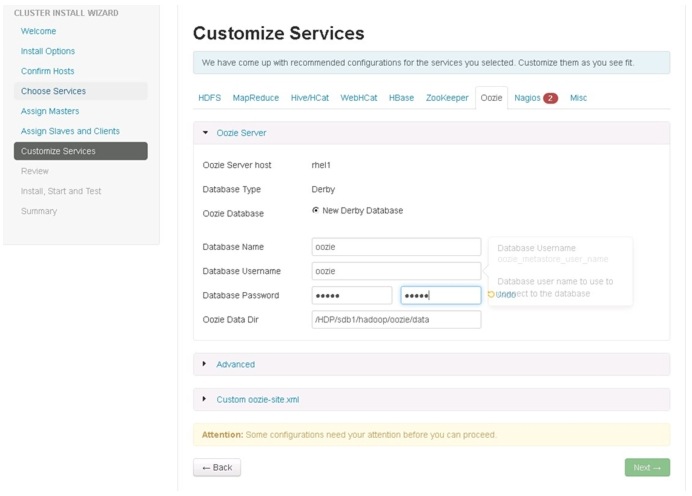
Nagios
Update the Nagios configuration as shown in Figure 89.
Enter the following in the Nagios window:
•
Nagios admin password as per organizational policy.
•
Hadoop admin email.
Figure 89 Customize Services - Nagios Window
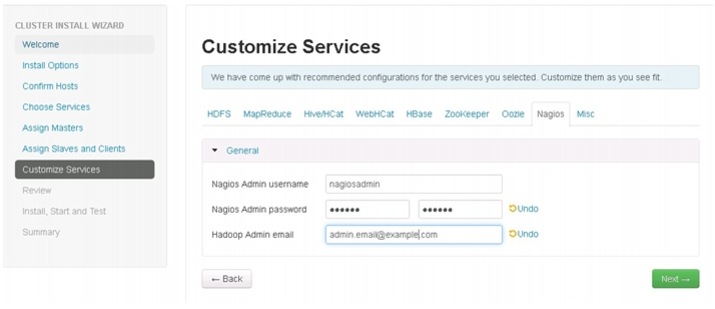
Misc
We can restore the default settings in the Misc window, no changes needed as shown in Figure 90.
Figure 90 Customize Services - Misc Window
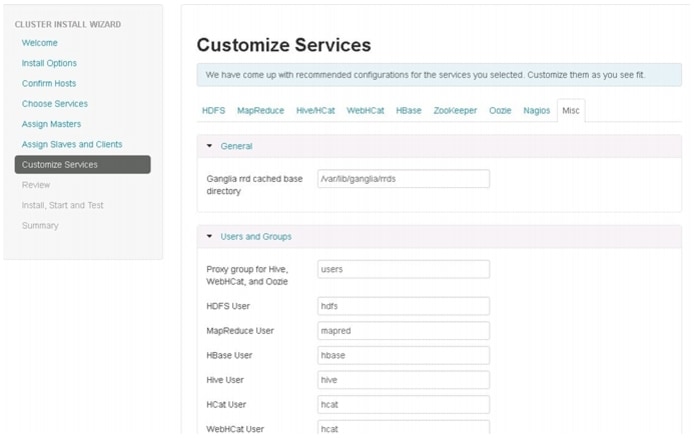
Review
Make sure the Review window shows all the configurations that you have done. Then click Deploy as shown in Figure 91. If any changes are to be made, use the left navigation bar to return to the appropriate screen.
Figure 91 Review Window
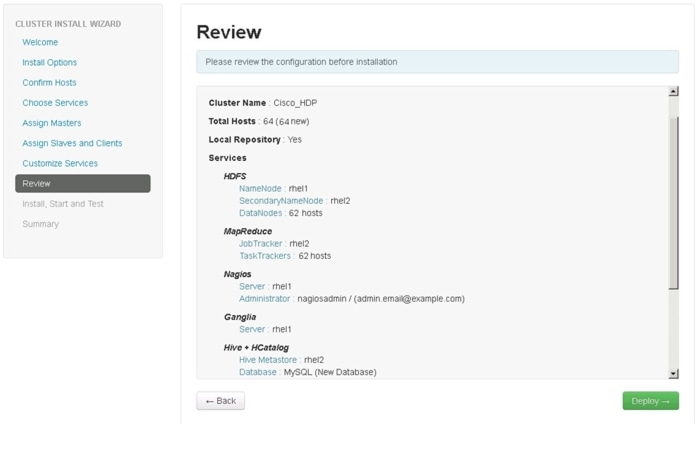
The installation process is shown by the progress indicator as shown in Figure 92. Each component when installed, gets started with a simple test which is run on each of the components. The overall status of the installed components are shown by the progress bar besides every host.
To see the specific information on what tasks have been completed per host, click the link in the Message column for the appropriate host. In the Tasks pop-up, select individual task to see the related log files. Select filter conditions by using the drop-down list. To see a larger version of the log contents, click Open. And to copy the contents to the clipboard, click Copy.
Depending on the components being installed per host, the entire process may take 30 or more minutes.
Click Next, when successfully installed and started the services message at the bottom of window appears as shown in Figure 92.
Figure 92 Cluster Install Wizard - Install, Start and Test Window
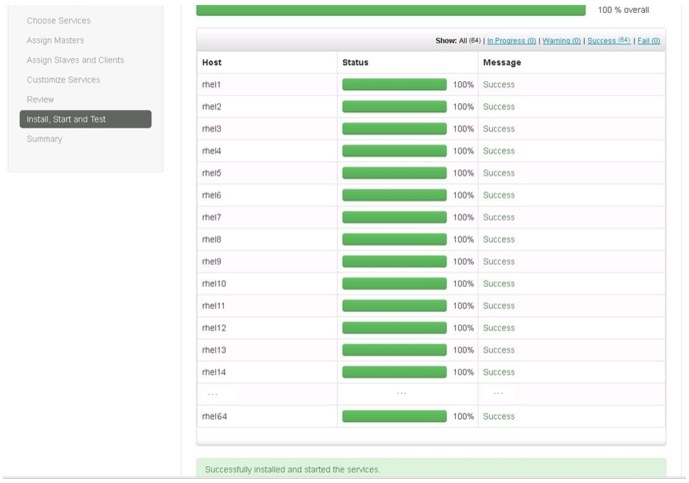
Summary of Installation Process
The summary page shows the accomplished tasks after the completion of cluster installation.
Figure 93 Cluster Install Wizard- Summary Window
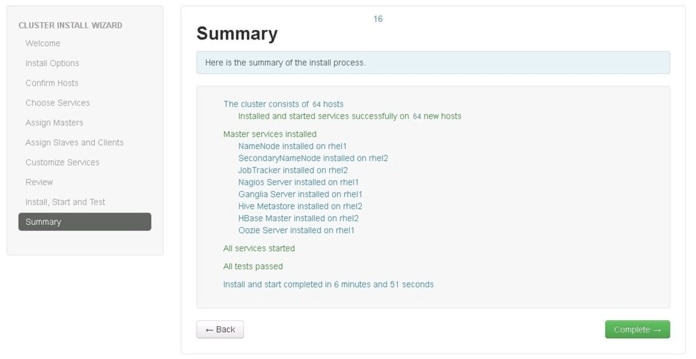
Conclusion
Hadoop has become a popular data management application across all the verticals. The Cisco CPA for Big Data for HDP offers a dependable deployment model for enterprise Hadoop that offer a fast and predictable path for businesses to unlock the value in big data.
The configuration details provided in this document can be extended to clusters of various sizes depending on application demands. Up to 160 servers (10 racks) can be supported without an additional switching in a single UCS domain. Each additional rack requires two Cisco Nexus 2232PP 10GigE Fabric Extenders and 16 Cisco UCS C240M3 Rack-Mount Servers. Scaling beyond 10 racks (160 servers) can be implemented by interconnecting multiple UCS domains using Nexus 6000/7000 Series switches. The solution is scalable to thousands of servers and to hundreds of petabytes storage, and is managed from a single pane using Cisco UCS Central.
Bill of Material
This section provides the hardware and software components used in the design setup for deploying the 64-node High Performance Cluster.
Table 10 describes the BOM for the master rack; Table 11 describes the BOM for expansion racks (rack 2 to 4); and Table 12 and Table 13 describe the BOM for the software components
Table 12 RedHat Enterprise Linux License
RHEL-2S-1G-3A
Red Hat Enterprise Linux
64
CON-ISV1-RH2S1G3A
3 year Support for Red Hat Enterprise Linux
64
 Feedback
Feedback